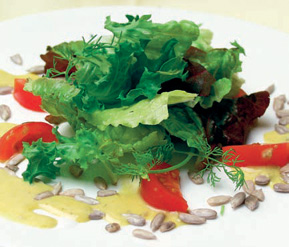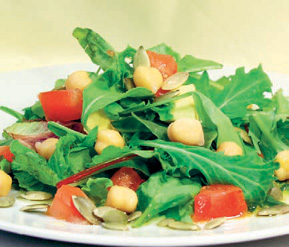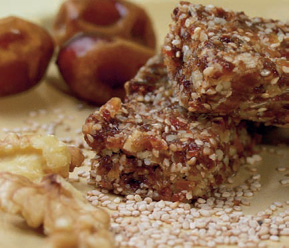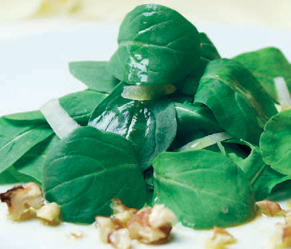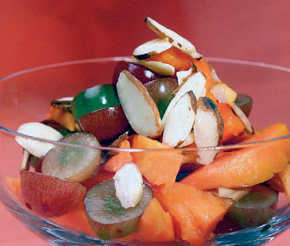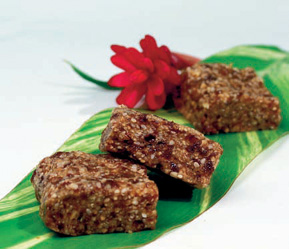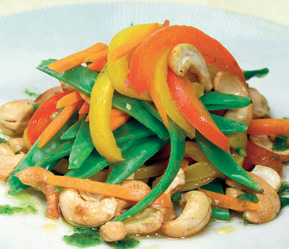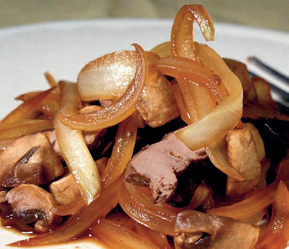STEP-BY-STEP RECIPE
The Healthiest Ways of Preparing Sunflower Seeds
health benefits of sunflower seeds
Promote Brain Health
Sunflower Seeds are an excellent source of vitamin E, which has been suggested to play an important role in promoting brain health. A multi-year population-based study showed that people with the highest intake of vitamin E from foods had a 32% reduction in their rate of mental decline compared to those with the least vitamin E in their diets. Previous research had suggested that people who consume more vitamin E retain mental function and are less likely to develop Alzheimer’s disease. Sunflower Seeds are also a very good source of vitamin B1, which is necessary for the production of acetylcholine, a neurotransmitter molecule essential for memory.
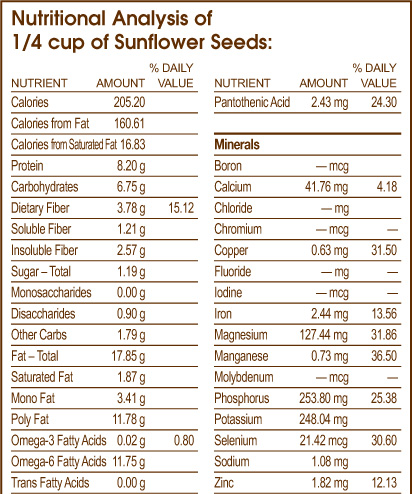
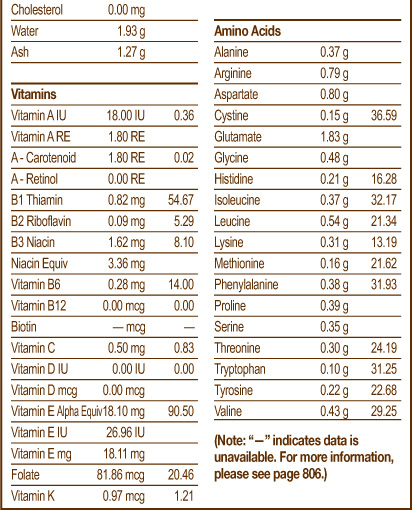
Promote Heart Health
Vitamin E also plays an important role in the prevention of cardiovascular disease. It helps prevent free radicals from oxidizing cholesterol, curbing the process of atherosclerosis, which can lead to blocked arteries, heart attack or stroke. In fact, studies show that people who get a good amount of vitamin E in their diet are at a much lower risk of dying of a heart attack than people whose intake of vitamin E is marginal or inadequate. Additionally, a recently published study showed that women whose diets provided them with the highest blood levels of vitamin E had the lowest risk of high cholesterol and atherosclerosis. Sunflower Seeds are also a good source of other nutrients that promote heart health. Their magnesium helps to maintain balanced blood pressure, while their folate keeps homocysteine levels in check. Additionally, in many cases of heart disease, when oxidative damage has been found to be the cause of blood vessel damage, low intake of selenium, a mineral concentrated in Sunflower Seeds, has been identified as a contributing factor to the disease.
Promote Optimal Health
Vitamin E, the body’s primary fat-soluble antioxidant, travels throughout the body neutralizing free radicals that would otherwise damage fat-containing structures and molecules, such as cell membranes, brain cells and cholesterol. By protecting these cellular and molecular components, vitamin E has significant anti-inflammatory effects that can contribute to the reduction of symptoms of asthma, osteoarthritis and rheumatoid arthritis, conditions where free-radicals and inflammation play a big role.
Additional Health-Promoting Benefits of Sunflower Seeds
Sunflower Seeds are a concentrated source of many other nutrients providing additional health-promoting benefits. These nutrients include free-radical-scavenging manganese and copper, energy-producing vitamin B5 and phosphorus, and sleep-promoting tryptophan.
flaxseeds
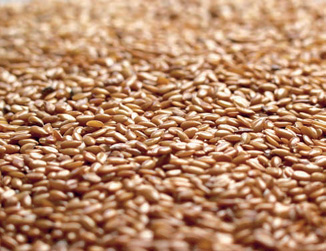
highlights

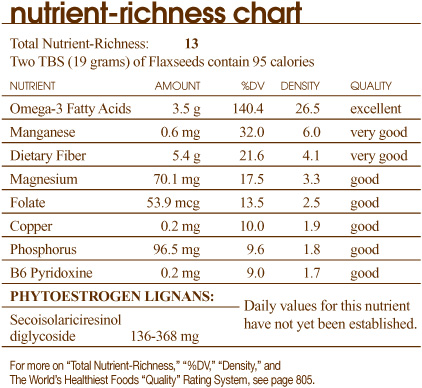
Charlemagne, the famous emperor who helped reshape European history, was also instrumental in the rise in popularity of Flaxseeds. He was so impressed with the versatility of Flax (as a food, medicine and as the source of fiber to make linen) that he passed laws requiring not only its cultivation, but also its consumption. Today, adding the warmly earthy and slightly nutty flavor of Flaxseeds to cereals, baked goods and other recipes is a great way to enjoy them as part of your “Healthiest Way of Eating.”
why flaxseeds should be part of your healthiest way of eating
Flaxseeds are the most concentrated plant source of the omega-3 fatty acid, alpha-linolenic acid (ALA), a precursor to the omega-3s found in cold-water fish. Omega-3 fatty acids are heart-healthy nutrients that also have anti-inflammatory properties. (For more on plant-based versus fish-based Omega-3 Fatty Acids, see page 770.) Flaxseeds also contain phytoestrogens, estrogen precursors found in plants, known as lignans, which help to balance estrogen levels in the body and also have antioxidant properties. (For more on the Health Benefits of Flaxseeds and a complete analysis of their content of over 60 nutrients, see page 513.)
varieties of flaxseeds
The botanical name for the Flax plant, Linum usitatissimum, means “most useful.” This aptly describes the versatility of Flax, with its ability to be used as a food, medicine and cloth material. Originating in Mesopotamia, it has been used since the Stone Age. One of the first records of the culinary use of Flaxseeds dates back to ancient Greece. Flaxseeds are slightly larger than sesame seeds and have a hard shell, which is smooth and shiny. Their color ranges from deep amber to reddish brown, depending upon whether the Flax is of the golden or brown variety. Flaxseeds can be purchased whole, as Flaxseed meal or as Flaxseed oil.
the peak season available year-round.
biochemical considerations
GLYCOSIDE COMPOUNDS
While Flaxseeds contain cyanogenic glycoside compounds, at normal intake levels and without protein malntrition, researchers currently maintain that this is not of concern and should cause no adverse effects (they consider 50 grams, which is more than 2 TBS, to be a safe amount for most people). The heat employed by cooking has been found to eliminate the presence of these compounds.
3 steps for the best tasting and most nutritious flaxseeds
Enjoying the best tasting Flaxseeds with the most nutrients is simple if you just follow my 3 easy steps:
1. The Best Way to Select
2. The Best Way to Store
3. The Best Way to Prepare
1. the best way to select flaxseeds
Flaxseeds are generally available in prepackaged containers as well as bulk bins. It is best to check and make sure that the store where you buy bulk Flaxseeds has a quick turnover of inventory and that the bulk containers are sealed well in order to ensure maximum freshness.
Whether purchasing Flaxseeds in bulk or in a packaged container, make sure that no evidence of moisture is present. While Flaxseeds can be purchased preground, I always prefer to buy whole Flaxseeds and grind them at home whenever I need them. Whole Flaxseeds have a longer shelf life than preground seeds. As with all seeds, I recommend selecting organically grown Flaxseeds whenever possible. (For more on Organic Foods, see page 113.)
Flaxseed oil should be expeller cold pressed and organic. It should be in an opaque bottle and kept in the refrigerator case at the grocery. Filtered Flaxseed oil is processed to remove many of the contaminants.
2. the best way to store flaxseeds
Whole Flaxseeds should be stored in an airtight container in a dark, dry and cool place (ideally, the refrigerator) where they will keep fresh for 3 months. To extend the shelf life of Flaxseeds, you can store them in the freezer where they will keep for 6 months.
Flaxseed oil should always be refrigerated. Since the most delicate part of the chemistry of Flaxseed oil is the portion containing the omega-3 fatty acids, refrigeration is important to help protect it from oxidative rancidity.
3. the best way to prepare flaxseeds
Always grind Flaxseeds before serving. In order to derive benefit from Flaxseeds, they need to be ground to break their hard shells and allow for the digestion and absorption of their nutrients. Whole shelled Flaxseeds can be ground in a coffee grinder. Be sure to clean the grinder well both before and after grinding seeds.
Flaxseeds are stabilized (at 110°F/43°C) before they are sold to help prevent them from going rancid, which allows the addition of Flaxseeds to baked items without damaging their delicate oils.
health benefits of flaxseeds
Promote Optimal Health
Flaxseeds are one of the most concentrated food source of alpha-linolenic acid (ALA), an omega-3 fatty acid, . ALA has numerous benefits including being a readily used form of energy and a fatty acid essential for proper skin function; it also inhibits inflammatory compounds made from linoleic acid. Additionally, ALA is the precursor to eicosapentaenoic acid (EPA) and docosahexaenoic acid (DHA), the acclaimed fatty acids found in fish. Omega-3 fatty acids are well-known for their anti-inflammatory properties.
Promote Heart Health
While small in size, Flaxseeds have big benefits for heart health. Studies have found that diets rich in ALA are associated with a lower risk of atherosclerotic plaques and of dying from heart disease or sudden cardiac death. Individuals who followed ALA-rich diets have been found to have lower total cholesterol, LDL cholesterol and triglycerides, with recent studies also finding that individuals who consume Flaxseed oil have reduced levels of inflammatory markers, including C-reactive protein. Additionally, EPA and DHA have been found to be associated with reduced plasma triglycerides and VLDL (very low density cholesterol, the most dangerous form of LDL), protection against coronary heart disease and reduction of hypertension. Flaxseeds are also a good source of folate, vitamin B6 and magnesium, three other nutrients vital for heart health. (For more on plant-based Omega-3 Fats, see page 770.)
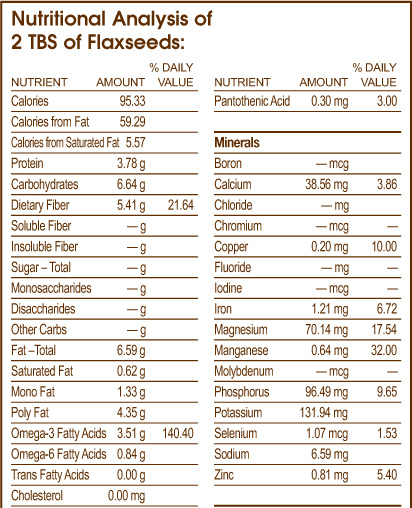
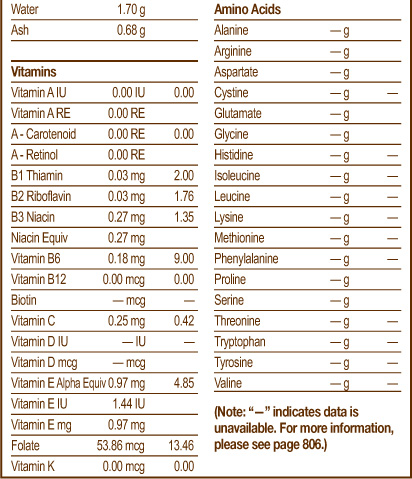
Promote Women’s Health
Of more than 60 foods tested, Flaxseeds were found to be the most concentrated source of special lignan phytoestrogens, phytonutrients that are converted by beneficial intestinal flora into two hormone-like substances called enterolactone and enterodiol. These hormone-like agents demonstrate a number of protective effects against breast cancer and are believed to be one reason that a vegetarian diet is associated with a lower risk for breast cancer. Studies show that women with breast cancer and women who eat meat typically excrete much lower levels of lignans in their urine than female vegetarians without breast cancer. In animal studies conducted to evaluate the beneficial effects of lignans, supplementing a high-fat diet with Flaxseed flour reduced early markers for mammary cancer in laboratory animals by more than 55%. (For more on Phytoestrogens, see page 774.)
Promote Digestive Health
Flaxseeds are a very good source of dietary fiber, containing insoluble and soluble fiber in a ratio of 2 to 1. Flaxseeds have been found to have a laxative effect, decreasing symptoms of constipation and increasing frequency of bowel movements in both young and old subjects. The fiber in Flaxseeds is suggested to have a cholesterol-lowering effect by preventing the reabsorption of cholesterol from the colon.
Additional Health-Promoting Benefits of Flaxseeds
Flaxseeds are a concentrated source of many other nutrients providing additional health-promoting benefits. These nutrients include free-radical-scavenging manganese and copper and bone-building phosphorus.
Here are questions that I have received from readers of the whfoods.org website about Flaxseeds:
Q Can you bake with Flaxseeds or are the omega-3 fatty acids damaged by heat?
A While it is not recommended to heat Flaxseed oil because it is very delicate and can oxidize, research shows that the combination of healthy omega-3 oils and lignan phytonutrients in Flaxseeds are surprisingly heat stable. Not only is it safe to leave whole Flaxseeds at room temperature, but you can also use them in baking.
Using ground or whole Flaxseeds in baking does not significantly impact their omega-3 fats. Numerous studies testing the amount of omega-3 fat in baked goods indicate no significant breakdown or loss of beneficial fats occurs in baking. In one study, women who ate raw, ground Flaxseeds daily for four weeks had similar plasma fatty acid profiles as those who ate milled Flaxseeds that had been baked in bread. Both groups of women showed a lowering of total cholesterol and “bad” LDL cholesterol.
Researchers speculate that the omega-3 fats in Flaxseeds are resistant to heat because of the presence of plant lignans (like secoisolariciresinol) in Flaxseeds; these phytonutrients are transformed into mammalian lignans (like enterodiol and enterolactone) in the body. So, enjoy this World’s Healthiest Food in baked goods as well as raw—either way, you’ll receive plenty of healthy benefits.
Q I know that Flaxseeds are rich in dietary fiber. What is the breakdown of their insoluble and soluble fiber?
A The ratio of insoluble fiber to soluble fiber in Flaxseed is 2:1. In other words, two-thirds of the fiber is insoluble and one-third is soluble. The insoluble fiber is mostly lignin (not to be confused with phytoestrogenic lignans), which has benefits on gastrointestinal health. The soluble fiber is mostly mucilage, and it’s this type of fiber that benefits cholesterol levels and blood sugar balance and promotes the growth of intestinal “good flora.”
STEP-BY-STEP RECIPE
The Healthiest Ways of Preparing Flaxseeds
sesame seeds
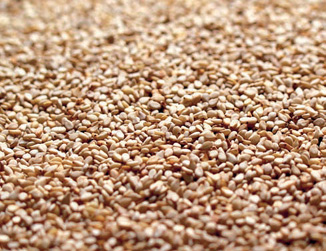
highlights

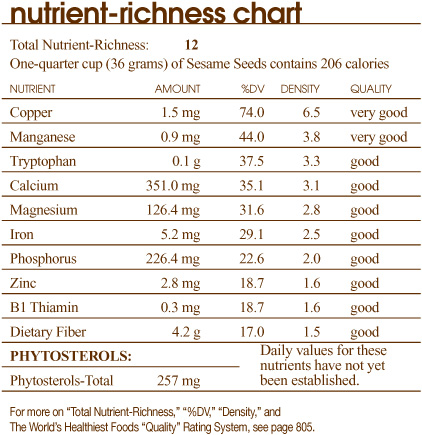
Sesame Seeds were believed to have originated in India where they are mentioned in early Hindu legends as a symbol of immortality. Sesame Seeds may be the oldest condiment known to man, dating back to as early as 1,600 BC. According to ancient Assyrian legends, wine made from Sesame Seeds was drunk by the gods when they created the world. Sesame Seeds are tiny, flat, oval seeds with a nutty taste and a delicate, almost invisible crunch that will make a tasty addition to your “Healthiest Way of Eating,” especially for those dishes with an Asian flair.
why sesame seeds should be part of your healthiest way of eating
Sesame Seeds are a good source of copper, a trace mineral important in a number of anti-inflammatory and antioxidant enzyme systems. They are rich in unique lignan phytonutrients, sesamin and sesamolin, which have been found to have antioxidant and anti-inflammatory properties. (For more on the Health Benefits of Sesame Seeds and a complete analysis of their content of over 60 nutrients, see page 520.)
varieties of sesame seeds
Sesame Seeds are the main ingredient in the Middle Eastern sweet dessert called halvah. “Open Sesame,” the famous phrase from the Arabian Nights, reflects the distinguishing feature of the Sesame Seed pod, which bursts open when it reaches maturity. The scientific name for Sesame Seeds is Sesamun indicum. Sesame Seeds come in two forms and a variety of different colors, including white, yellow, black and red:
UNHULLED
These seeds are darker in color and have their bran intact. They are more nutritious than the hulled variety. One-hundred grams of unhulled Sesame Seeds contain 989 mg of calcium while the same amount of unhulled seeds contains 131 mg.
HULLED
These seeds are very light in color and have had their bran portion removed. They come both roasted and unroasted.
TAHINI
Middle Eastern Sesame paste made from Sesame Seeds. Raw tahini is more nutrient-rich than roasted tahini.
ASIAN SESAME PASTE
Paste made from toasted Sesame Seeds.
the peak season available year-round.
3 steps for the best tasting and most nutritious sesame seeds
Enjoying the best tasting Sesame Seeds with the most nutrients is simple if you just follow my 3 easy steps:
1. The Best Way to Select
2. The Best Way to Store
3. The Best Way to Prepare
1. the best way to select sesame seeds
Sesame Seeds are generally available in prepackaged containers and can also be found in bulk bins. It is best to check and make sure that the store where you buy Sesame Seeds in bulk has a quick turnover of inventory and that the bulk containers are sealed well in order to ensure maximum freshness. Whether purchasing Sesame Seeds in bulk or in a packaged container, make sure no evidence of moisture is present. Additionally, since Sesame Seeds have high oil content and can become rancid, it is good to smell those from bulk bins to ensure that they smell sweet and fresh, not bitter or rancid. As with all seeds, I recommend selecting organically grown Sesame Seeds whenever possible. (For more on Organic Foods, see page 113.)
2. the best way to store sesame seeds
Unhulled Sesame Seeds are best stored in an airtight container in a cool, dry, dark place. They will last for 6 months in the refrigerator and 1 year in the freezer. Once the seeds are hulled, they are much more prone to rancidity; hulled Sesame Seeds should be stored in the refrigerator, where they will last for about 3 months, or in the freezer, where they should remain fresh for up to a year. Opened containers of tahini and Asian Sesame paste should be refrigerated.
3. the best way to prepare sesame seeds
The best way to prepare Sesame Seeds is to dry roast them. For details, see below.
Q I have been told that Sesame oil is good for reducing high blood pressure. Is this true?
A While Sesame oil is not as nutrient-rich as Sesame Seeds, it has been researched for a variety of cardiovascular benefits, including blood pressure reduction. Most of the beneficial effects are thought to come from the special lignan phytonutrients that they contain. What is interesting is that while there are some naturally occurring lignans found in Sesame Seeds (sesamin and sesamolin), some of the lignans that are being studied for their health benefits (episesamin and sesaminol) are actually created during the process of making Sesame oil and don’t exist in the seeds themselves.
There have been several animal studies that investigated the effect of dietary Sesame lignans on blood pressure and found that it caused reductions in blood pressure and the physiological damage usually associated with elevated blood pressure. Just recently, results of a human clinical trial supported these earlier animal study findings. Individuals who were on calcium-channel blocker medicine and given 35 grams of Sesame oil per day for 60 days were found to have not only a reduction in blood pressure but also a reduction of triglycerides and LDL (the “bad” cholesterol) and an elevation in HDL (the “good” cholesterol). Additionally, markers of antioxidant activity significantly increased in the Sesame oil supplemented individuals.
Q Can you cook with Sesame oil?
A Like with many other oils, I would rather use Sesame oil in either dressings or drizzled on foods as opposed to heating it in order to prevent oxidation from occurring. Yet, low temperature cooking, such as that involved with making sauces, may be okay for Sesame oil.
Q Are Sesame Seeds OK for children to eat?
A While Sesame Seeds are incredibly rich in nutrients, it is a food to which some people have adverse reactions. It seems that children are becoming increasingly sensitive to Sesame Seeds; sensitivity is growing in terms of its prevalence of allergenicity, especially among infants and children if there is a family history of allergies, asthma or eczema.
Q Given the high calcium content of Sesame Seeds, is tahini a good source to use as I look to incorporate more non-dairy calcium sources into my diet?
A Sesame Seeds are a rich source of calcium. One tablespoon of tahini contains 63 mg of cal-cium. Therefore, calcium intake is another good reason to incorporate tahini into your “Healthiest Way of Eating” (in addition to its other nutritional benefits including its lignan phytonutrients as well as its great taste and texture).
Yet, I wouldn’t just focus on tahini as a non-dairy source of calcium as that 63 mg of calcium will “cost” you 86 calories. Therefore, if you were wanting to get a substantial amount of calcium, say 25% of your daily calcium needs (250 mg) from tahini, it would “cost you” over 340 calories.
A little known nutrition fact (although it should be a widely known one) is that there are actually many non-dairy foods that are rich in calcium. For example, one cup of boiled spinach has over 244 mg of calcium, yet only 41 calories, while one cup of cooked collard greens offers about 226 mg of calcium for less than 50 calories. Therefore, these and other plant-based foods can serve as great sources of calcium but “cost” you less calories.
This is not to dissuade you from eating tahini. It is a wonderful food and one of my favorites. I use it in a lot of recipes. But if you enjoy the other plant-based foods that are rich in calcium, I would not suggest that you make tahini your primary source for this important mineral.
STEP-BY-STEP RECIPE
The Healthiest Ways of Preparing Sesame Seeds
health benefits of sesame seeds
Rich in Unique Health-Promoting Phytonutrients
Sesame Seeds contain the unique lignan phytonutrients, sesamin and sesamolin. Once in the body, sesamolin gets converted to sesamol, another lignan with health-promoting effects. Research on these compounds has yielded very exciting findings. In animals, Sesame Seed lignans have been found to have cholesterol- lipoprotein- and blood-pressure-lowering effects. They have been found to have antioxidant activity, to increase vitamin E supplies and to protect the liver from oxidative damage. In addition, preliminary research suggests that sesamin and sesamol may have anti-inflammatory properties since they have been found to inhibit the delta-5-desaturase enzyme, which converts omega-6 fatty acids into arachidonic acid; the latter fatty acid is known to be a precursor for molecules that promote inflammation. Sesame Seeds are also a highly concentrated source of phytosterols, plant nutrients that may help to reduce cholesterol.
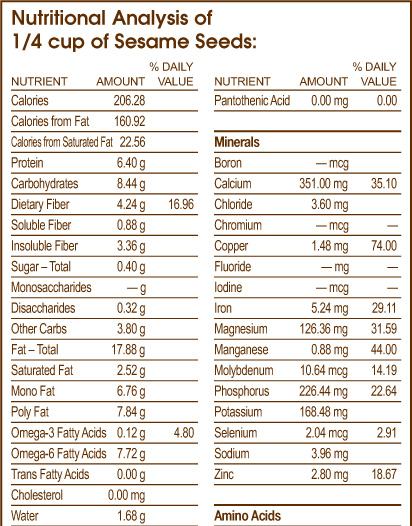
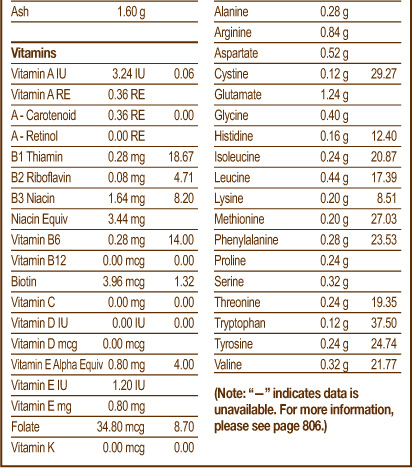
Promote Joint and Skin Health
Sesame Seeds are a very good source of copper, a trace mineral that is important in a number of anti-inflammatory and antioxidant enzyme systems. Copper plays an important role in the activity of lysyl oxidase, an enzyme needed for the cross-linking of collagen and elastin—the ground substances that provide structure, strength and elasticity to blood vessels, bones, joints and skin.
Promote Bone Health
Calcium’s most highly recognized role has been to prevent the bone loss that can occur as a result of menopause or other conditions, such as rheumatoid arthritis. Sesame Seeds are also rich in other bone-supportive nutrients. They are a good source of magnesium and phosphorus, minerals which serve as “scaffolding” to support the integrity of bone. They are also a very good source of copper and manganese and a good source of zinc, three trace minerals that are cofactors in enzymes that help to promote the construction of the bone matrix. In fact, a recent study found low dietary intake of zinc to be correlated with both low blood levels of this trace mineral and osteoporosis of the hip and spine in middle to older age men.
Additional Health-Promoting Benefits of Sesame Seeds
Sesame Seeds are also a concentrated source of many other nutrients providing additional health-promoting benefits. These nutrients include energy-producing iron and vitamin B1, digestive-health-supporting dietary fiber, and sleep-promoting tryptophan.
A Serving of Nuts and Seeds Won’t Make You Fat
Yes, it’s true that nuts and seeds do contain a good amount of fat and therefore calories. But, eaten in small quantities—a serving is just two to four tablespoons—these highly nutritious members of the World’s Healthiest Foods deliver not only delicious flavor but also nutritional benefits that can help protect you against cardiovascular disease. A handful of almonds, pumpkin seeds or walnuts, eaten as a healthy snack or used as a flavorful addition to a tossed green salad, will not make you fat. Too many bowls full of salty nuts washed down with several beers may.
Nuts’ and Seeds’ Healthy Fats
Not only will reasonable amounts of nuts and seeds not make you fat but the fat found in nuts and seeds is the primary reason eating them promotes a healthy heart. The fats that nuts and seeds contain is mostly polyunsaturated, although they also contain a little monounsaturated and a very small amount of saturated fat. The proper balance between these types of fats is important, and many people do not get enough of certain types, especially one type of polyunsaturated fat called omega-3. Nuts and seeds are rich sources of a type of omega-3 fat called alpha-linolenic acid (ALA), which belongs to the same family of omega-3 fats as the heart-healthy fats you may have heard about in cold-water fish.
The omega-3 fatty acids found in nuts and seeds may help prevent heart disease and repeat heart attacks in several ways. Omega-3 fatty acids, including ALA, EPA and DHA, are protective fats that have been found to:
• Lower blood cholesterol and triglyceride levels, which, when elevated, are both risk factors for heart disease.
• Decrease platelet aggregation, which when excessive can cause “sticky” blood. Like aspirin, omega-3s “thin” the blood. The blood doesn’t actually become thinner; what happens is that the red blood cells no longer clump together, so the blood flows more freely through the blood vessels, which is especially helpful in vessels that may be partially clogged with cholesterol build-up. If the blood is “sticky,” clumps of red blood cells may form a clot that blocks a narrowed artery, triggering a heart attack if the blood vessel feeds the heart, or a stroke if the blood vessel is in the brain.
• Reduce the formation of artery-clogging atherosclerotic plaque. Once platelets aggregate or stick together, they release a substance that contributes to the process through which cholesterol is used to form atherosclerotic plaque. When atherosclerotic plaque builds up in the blood vessels, blood flow is decreased to a minimum or stopped altogether, precipitating a heart attack or stroke. By reducing platelet aggregation, omega-3s may help short-circuit this whole process.
• Reduce inflammation of the blood vessels. If blood vessels are inflamed, blood flow is reduced. Omega-3s are used within the body to produce anti-inflammatory chemical messengers called the series E3 prostaglandins, which by lessening blood vessel inflammation can improve blood flow.
• Lower blood pressure, another major risk factor for heart attacks and strokes. All the ways in which omega-3 fats promote blood vessel health contribute to maintenance of clear, open vessels through which blood flows easily.
More Healthy Reasons to Eat Nuts and Seeds
Nuts and seeds are a rich source of plant protein, which is needed not only to build and maintain all body tissues, but for a healthy immune system as well. A handful of nuts or seeds will also provide you with fiber. The fiber in nuts and seeds helps keep your digestive tract, specifically your colon, in good health and also promotes the health of your blood vessels since the soluble portion of their fiber helps lower blood cholesterol—another boon to heart health.
Nuts and seeds may even help those who wish to lose weight. The combination of protein, fiber and healthy fats provided by nuts and seeds helps keep blood sugar levels stable, which helps keep us from getting hungry too soon after eating.
In addition to the cardioprotective fats, plant protein and dietary fiber nuts provide, new research indicates that nuts and seeds are rich sources of other bioactive molecules that support cardiovascular health. These include plant sterols, antioxidant phenolics and numerous other phytonutrients—natural substances in plants that are beneficial to our health—that may be protective against chronic diseases.
Many phytonutrients act as powerful antioxidants, which can improve cardiovascular health because they destroy free radicals that can harm the lining of the blood vessels. Tiny micro-injuries in the lining of the vessel are a precursor to plaque development, which can eventually clog the artery. Yet another cardioprotective effect from a few nuts and seeds!
pumpkin seeds
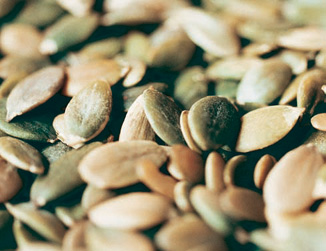
highlights

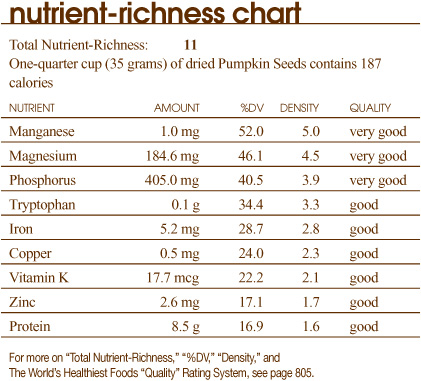
Pumpkin Seeds were a celebrated food of the Native Americans, who treasured them for their dietary and medicinal properties. They are also a special hallmark of traditional Mexican cuisine and a popular snack in Mexico. So, don’t toss away the seeds you scrape out of your Halloween pumpkin; they can be toasted and eaten as a delicious snack or added to your favorite salad, soup or fish dish. Of course, you don’t have to wait for Halloween to enjoy Pumpkin Seeds. They are readily available in bulk or prepackaged at your local natural food store any time of year. Chewy, subtly sweet and nutty, Pumpkin Seeds make a great addition to your “Healthiest Way of Eating.”
why pumpkin seeds should be part of your healthiest way of eating
Pumpkin Seeds are a good source of zinc, a hard-to-find mineral important for a healthy immune system. They are becoming increasingly popular not only because of their overall nutrient-richness, but because scientific research is finding their unique nutritional substances called cucurbitacins to have many health-promoting benefits. (For more on the Health Benefits of Pumpkin Seeds and a complete analysis of their content of over 60 nutrients, see page 526.)
varieties of pumpkin seeds
Some varieties of Pumpkin Seeds are encased in a yellow-white husk, although some varieties of pumpkins produce seeds without shells. Pumpkin Seeds, also known as pepitas, are flat, dark green seeds. Like cantaloupe, cucumber and squash, pumpkins belong to the gourd or Cucurbitaceae family. The most common genus and species name for pumpkin is Cucurbita maxima.
the peak season available year-round.
3 steps for the best tasting and most nutritious pumpkin seeds
Enjoying the best tasting Pumpkin Seeds with the most nutrients is simple if you just follow my 3 easy steps:
1. The Best Way to Select
2. The Best Way to Store
3. The Best Way to Prepare
1. the best way to select pumpkin seeds
Pumpkin Seeds are generally available in prepackaged containers as well as bulk bins. It is best to check and make sure that the store where you buy Pumpkin Seeds in bulk has a quick turnover of inventory and that the bulk containers are sealed well in order to ensure maximum freshness. The Pumpkin Seeds should be uniform in color and not limp or shriveled. They should also smell sweet and nutty; be sure they do not smell rancid or musty. As with all seeds, I recommend selecting organically grown Pumpkin Seeds whenever possible. (For more Organic Foods, see page 113.)
If you want Pumpkin Seeds with a roasted flavor and texture, choose ones that have been “dry roasted” as they are not cooked in oil. The commercial roasting process of seeds is often a form of deep-frying, usually in saturated fat, such as coconut oil or palm kernel oil. Consumption of deep-fried foods has been linked to high levels of LDL (the “bad” form of cholesterol) and to thickening of larger artery walls.
Even “dry roasted” Pumpkin Seeds may be cooked at high temperatures that damage their natural oils. It is important to read the label to be sure that no additional ingredients such as sugar, corn syrup or preservatives have been added. For the highest quality, least expensive “dry roasted” Pumpkin Seeds, it’s best to just roast them yourself using “The Healthiest Way to Dry Roast Pumpkin Seeds.” (See below.)
You can now also find Pumpkin Seed butter in some natural food stores. It is a delicious addition to a squash soup or can be used as a spread, like peanut butter.
2. the best way to store pumpkin seeds
Pumpkin Seeds should be stored in an airtight container in the refrigerator. While they may stay edible for about 6 months, they seem to lose their peak freshness after about 1–2 months. Pumpkin Seeds can be stored in an airtight container in the freezer where they will keep for 1 year.
3. the best way to prepare pumpkin seeds
The best way to prepare Pumpkin Seeds is to dry roast them. For details, see below.
Q What is the difference between green and white Pumpkin Seeds?
A Like all plants, there are different species and varieties of Pumpkins, even though they all belong to the same family of plants (Cucurbitaceae). Green hulled Pumpkin Seeds are a variety usually referred to as pepitas. This variety of Pumpkin Seeds is especially popular in the southwestern United States and in Mexico. The hulls of Pumpkin Seeds are edible and high in fiber, but typically not eaten. (They may also be different in color than the inner seed.) White seeds and white or whitish-yellow hulls are very common to other pumpkin varieties. There is even a variety of pumpkin (the Lumina variety) that not only contains white seeds, but has a white outer skin.
I haven’t seen research documenting the nutritional differences between green and white varieties of Pumpkin Seeds. There can be a pretty wide range of values in the zinc and vitamin E content of Pumpkin Seeds, but I haven’t seen any studies that showed these differences to be associated with the color of the inner seed or the hull.
Q Do I need to separate Pumpkin Seeds from the outside husk, or is the whole seed edible?
A The hulls of Pumpkin Seeds are high in fiber, and although typically not eaten, they are edible, and you will find individuals who enjoy eating the hull.
Chewing is an extremely important, yet oftentimes overlooked, part of healthy digestion. Most people put food in their mouth, chew a few times and swallow their food, as if their sole focus was how quickly they could get their food to their stomach.
While our mothers might have repeatedly told us to “chew your food,” most people do not do this well, probably out of habit, conditioning and attitude towards food. When the idea of sitting down for a relaxing meal that focuses truly on the enjoyment and nutritional benefits of food takes second fiddle to the pressures and stress of our modern-day, on-the-go lifestyles, it is no surprise that many people do not slow down when they eat and take the time to chew their food.
Yet, in reality it doesn’t really take much time and effort to chew your food, and what you get in return is well worth it, with better health and a greater enjoyment of food being some of the rewards.
Digestion begins in the mouth
Most people think that digestion begins in the stomach. Yet, with proper, health-promoting digestion, this process actually begins in the mouth. The process of chewing is a vital component of the digestive activities that occur in the mouth, inextricably linked to good digestion and, therefore, to good health.
The mechanical process of digestion begins with chewing
The action of chewing mechanically breaks down very large aggregates of food molecules into smaller particles. This results in the food having increased surface area, an important contributing factor to good digestion. In addition to the obvious benefit of reduced esophageal stress that accompanies swallowing smaller, rather than larger, pieces of food, there is another very important benefit to chewing your food well that comes with its ability to be exposed to saliva for a longer period of time.
The chemical process of digestion begins with chewing
Food’s contact with saliva is important because it helps to lubricate the food, making it easier for foods (notably dried ones) to pass more easily through the esophagus and because saliva contains enzymes that contribute to the chemical process of digestion. Carbohydrate digestion begins with salivary alpha-amylase as it breaks down some of the chemical bonds that connect the simple sugars that comprise starches. Additionally, the first stage of fat digestion also occurs in the mouth with the secretion of the enzyme, lingual lipase, by glands that are located under the tongue.
Incomplete digestion can lead to bacterial overgrowth
When food is not well chewed, and the food fragments are too big to be properly broken down, incomplete digestion occurs. Not only do nutrients not get extracted from the food but undigested food becomes fodder for bacteria in the colon that can lead to bacterial overgrowth, flatulence and other symptoms of indigestion.
Chewing relaxes the lower stomach muscle
Chewing is directly connected with the movement of food through your digestive tract and, in particular, with the movement of your food from your stomach into your small intestine. At the lower end of your stomach, there is a muscle called the pylorus. This muscle must relax in order for food to leave your stomach and pass into your small intestine. Sufficient saliva from optimal chewing helps relax the pylorus and, in this way, helps your food move through your digestive tract in a healthy fashion.
Chewing triggers the rest of the digestive process
Yet, the contribution of chewing to good digestion does not even stop there. The process of chewing also activates signaling messages to the rest of the gastrointestinal system that triggers it to begin the entire digestive process. This is because when chewing is a well-paced, thorough process, it can actually be said to belong to the “cephalic stage of digestion,” the phase in which you first see, smell and taste your food. The length of time spent chewing the food is related to the length of the cephalic stage of digestion since with more extensive chewing, the longer the food gets to be seen, tasted and smelled.
Cephalic phase responses have been extensively analyzed in the research literature. The release of small messaging molecules critical for digestion, such as cholecystokinin, somatostatin and neurotensin, has been found to increase by over 50% just by the mere sight and smell of food. Additionally, research has shown how chewing and the activation of taste receptors in the mouth can prompt the nervous system that, in turn, relays information to the gastrointestinal system that expedites the process of digestion. For example, stimulation of the taste receptors can signal the stomach lining to produce hydrochloric acid that helps in the breakdown of protein. Additionally, chewing signals the pancreas to prepare to secrete enzymes and bicarbonate into the lumen of the small intestine.
Practical tips
For healthy digestion to occur, it is important to thoroughly chew your food. While various health professionals advocate distinct numbers of times you should chew food, I recommend more personal guidelines. I feel that instead of prescribing a set number of chews for each biteful people should get a sense of their own eating, and develop more of a relationship with their food, enhancing their own knowingness about what is best for their health.
My suggestion is that you chew your food completely until it is small enough and dissolved enough to be swallowed with ease. A good rule of thumb is as follows: if you can tell what kind of food you are eating from the texture of the food in your mouth (not the taste), then you haven’t chewed it enough. For example, if you are chewing broccoli and you run your tongue over the stalk and can tell that it is still a stalk or over the floret and you can tell that it is still a floret, don’t swallow. You need to keep on chewing until you can’t tell the stalk from the floret.
The benefits of thoroughly chewing your food will extend beyond improved digestion. It will cause you to slow down when you are eating, making more space for the enjoyment of your meal. Food will begin to taste even better when there is more focus and concentration on the process and act of eating. By chewing your food well, you will be able to better enjoy the benefits of the World’s Healthiest Foods—their abundance of nutrients and great, lively tastes.
STEP-BY-STEP RECIPES
The Healthiest Ways of Preparing Pumpkin Seeds
health benefits of pumpkin seeds
Promote Prostate Health
Increasing incidence of prostate enlargement in U.S. men has catapulted Pumpkin Seeds into the health spotlight. These seeds contain phytonutrients called cucurbitacins that can prevent the body from converting testosterone into a much more potent form called dihydrotestosterone. This makes it more difficult for the body to produce more prostate cells and therefore more difficult for the prostate to keep enlarging.
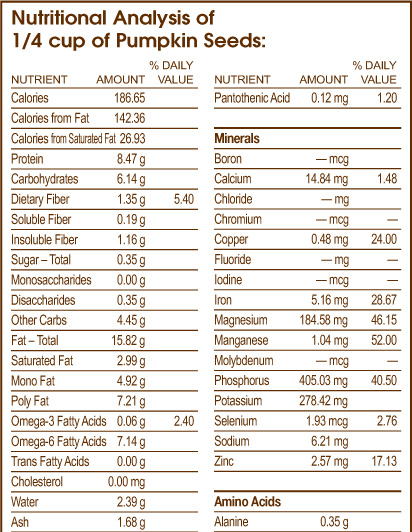
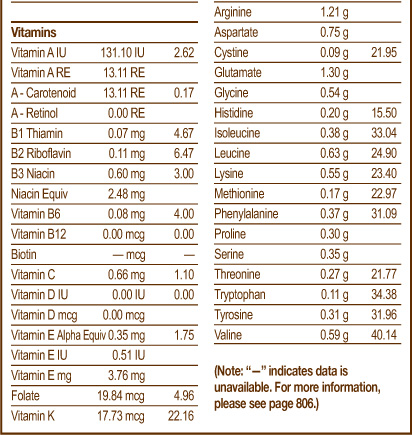
Promote Men’s Health
Pumpkin Seeds are a good source of zinc, a mineral long renowned for promoting men’s health. Now there may be yet another reason for men to concentrate on getting an adequate daily supply of zinc—bone mineral density. Although osteoporosis is often thought to be a disease for which postmenopausal women are at highest risk, it is also a potential problem for older men. Almost 30% of hip fractures occur in men, and one in eight men over age 50 will have an osteoporotic fracture. A recent study focusing on men over 45 years old found a clear correlation between low dietary intake of zinc, low blood levels of this trace mineral and osteoporosis at the hip and spine.
Promote Joint Health
The healing properties of Pumpkin Seeds have also been recently investigated with respect to arthritis. In animal studies, the addition of Pumpkin Seeds to the diet has compared favorably with the use of the non-steroidal anti-inflammatory drug indomethacin in reducing inflammatory symptoms. Additionally, Pumpkin Seeds did not have one extremely undesirable effect of indomethacin: unlike the drug, Pumpkin Seeds do not increase the level of damaged fats in the linings of the joints, a side effect that actually contributes to the progression of arthritis. Some of Pumpkin Seeds’ joint health benefits may come from their concentration of copper, which plays a role in promoting flexibility in bones and joints.
Important Protein Source
Pumpkin Seeds are such a concentrated source of protein that they are one of only two World’s Healthiest Nuts and Seeds that are rated as a good source of this important nutrient (the other one is peanuts). Our body uses dietary protein to create its structure, using it to build muscles and tissues. In addition, compounds vital to our health—such as enzymes and nutrient-transport proteins—are synthesized from dietary protein. And protein gives us slow burning energy that helps us to feel our best.
Additional Health-Promoting Benefits of Pumpkin Seeds
Pumpkin Seeds are also a concentrated source of other nutrients providing additional health-promoting benefits. These nutrients include free-radical-scavenging manganese, muscle-relaxing magnesium, energy-promoting iron and phosphorus, and sleep-promoting tryptophan.
walnuts
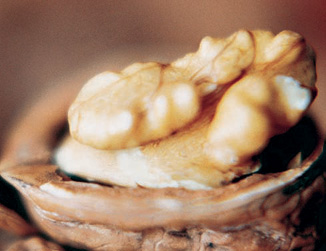
highlights

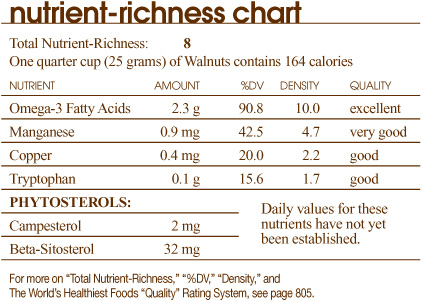
Originating in Persia, Walnuts are one of the oldest tree foods and were prized by the Romans who referred to them as the “Royal Nut of Jove.” (Jove was the king of their mythological gods.) Today, they remain highly esteemed not only for their delicious flavor, but also for their nutritional value. Add them to a salad in place of croutons, toss them into a “Healthy Sauté,” use them as a topping for both vegetables and desserts and enjoy their many health-promoting benefits as part of your “Healthiest Way of Eating.”
why walnuts should be part of your healthiest way of eating
Walnuts are a rich source of heart-healthy monounsaturated fats and an excellent source of those hard-to-find omega-3 fatty acids in the form of alpha-linolenic acid (ALA). Among numerous other benefits, diets rich in ALA have been found to be cardio-protective and provide anti-inflammatory benefits. (For more on the Health Benefits of Walnuts and a complete analysis of their content of over 60 nutrients, see page 532.)
varieties of walnuts
It is no surprise that the regal and delicious Walnut comes from an ornamental tree that is highly prized for its beauty. The Walnut kernel consists of two bumpy lobes that look like abstract butterflies. While there are numerous species of Walnut trees, three of the main types of Walnuts are:
ENGLISH (PERSIAN)
The English Walnut (Juglans regia) originated in India and the regions surrounding the Caspian Sea; this is why it is also known as the Persian Walnut. It is the most popular type of Walnut in the United States, featuring a thinner shell than other varieties that is easily broken with a nutcracker. It is the variety featured in the photographs in this chapter.
BLACK WALNUT
The Black Walnut (Juglans nigra) has a thicker shell, which is harder to crack, and a very pungent distinctive flavor.
WHITE (BUTTERNUT)
The White Walnut (Juglans cinerea) features a sweeter and oilier taste than the other two varieties. However, they are not as widely available and may be more difficult to find in the marketplace.
the peak season available year-round.
3 steps for the best tasting and most nutritious walnuts
Enjoying the best tasting Walnuts with the most nutrients is simple if you just follow my 3 easy steps:
1. The Best Way to Select
2. The Best Way to Store
3. The Best Way to Prepare
1. the best way to select walnuts
Walnuts are generally available in prepackaged containers as well as bulk bins. Walnuts stored in hermetically sealed containers will last longer than those sold in bulk since their exposure to heat, air and humidity is reduced. If I am going to buy Walnuts from bulk bins, I always check to make sure that the store where I buy Walnuts has a quick turnover of inventory and that the bulk containers are well sealed in order to ensure maximum freshness. The Walnuts should be uniform in color and not limp or shriveled. They should also smell sweet and nutty; be sure they do not smell rancid or musty.
When purchasing whole Walnuts that have not been shelled, I select ones that feel heavy for their size. Their shells should not be cracked, pierced or stained, as this is oftentimes a sign of mold developing on the nutmeat, which makes it unsafe for consumption. As with all nuts, I recommend selecting organically grown Walnuts whenever possible. (For more on Organic Foods, see page 113.)
If you want Walnuts with a roasted flavor and texture, choose ones that have been “dry roasted” as they are not cooked in oil. The commercial roasting process of nuts is often a form of deep-frying, usually in saturated fat, such as coconut or palm kernel oil. Consumption of deep-fried foods has been linked to high levels of LDL (the “bad” form of cholesterol) and to thickening of larger artery walls.
Even “dry roasted” Walnuts may be cooked at high temperatures that damage their natural oils. It is important to read the label to be sure that no additional ingredients such as sugar, corn syrup or preservatives have been added. For the highest quality, least expensive “dry roasted” Walnuts, it’s best to just roast them yourself using “The Healthiest Way to Dry Roast Walnuts” (See below.)
2. the best way to store walnuts
Due to their high polyunsaturated fat content, Walnuts are extremely perishable and care should be taken in their storage. Shelled Walnuts should be stored in an airtight container and placed in the refrigerator, where they will keep for 6 months, or the freezer, where they will last for 1 year. Unshelled Walnuts should preferably be stored in a cool, dry, dark place where they will stay fresh for up to 6 months.
3. the best way to prepare walnuts
Whole shelled Walnuts can be chopped by hand or can be placed in a food processor. If using a food processor, it is best to pulse on and off a few times instead of running the blade constantly, as this will help ensure that you end up with chopped Walnuts rather than Walnut butter.
Q I know that Walnuts are a source of omega-3s, but I also thought that they contained a lot of omega-6s as well. What is the ratio of Omega-6:3 in Walnuts and are they beneficial? I am trying to reduce the omega-6:3 ratio in my diet as I know it is better for my overall health.
A Foods that contain omega-3 fatty acids (even salmon, one of the most renowned sources of these nutrients) will usually also contain omega-6 fatty acids as well. So, the fact that Walnuts contain them is no surprise. Yet, the ratio between omega-6 and omega-3 is about 4:1 in Walnuts, which is a much lower ratio than in many foods. Researchers estimate that many people who follow a Western diet have a omega-6:omega-3 ratio of about 20:1 and propose that closer to 2:1 would help reduce the incidence of inflammatory diseases. So, as you see, the ratio of these fatty acids in Walnuts falls within the overall target. This is why Walnuts are one of the recommended foods for individuals who are trying to increase their omega-3 intake, reduce their omega-6 intake, and shift the balance of essential fatty acids. It is important to remember that it is not just about adding the Walnuts, for example, to your diet, but trying to have them replace another food that may contain more omega-6s and less omega-3s.
There are other foods that are rich in omega-3s and have an even lower omega-6 to omega-3 ratio than Walnuts. These include flaxseeds (0.24:1) and cold-water fish such as salmon (0.18:1).
STEP-BY-STEP RECIPE
The Healthiest Ways of Preparing Walnuts
health benefits of walnuts
Promote Heart Health
Adding Walnuts to your diet can be an important step in improving your cardiovascular health. In fact, the FDA has recently allowed the health claim that “eating 1.5 ounces per day of Walnuts as part of a diet low in saturated fat and cholesterol may reduce the risk of heart disease.”
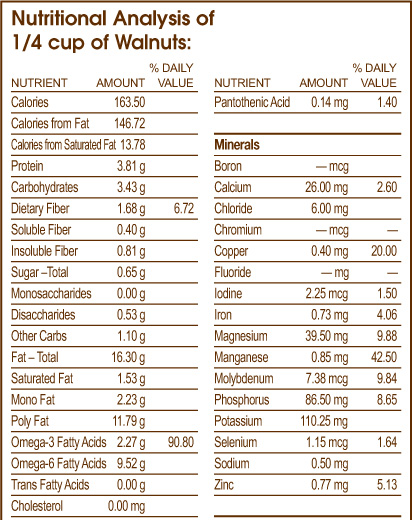
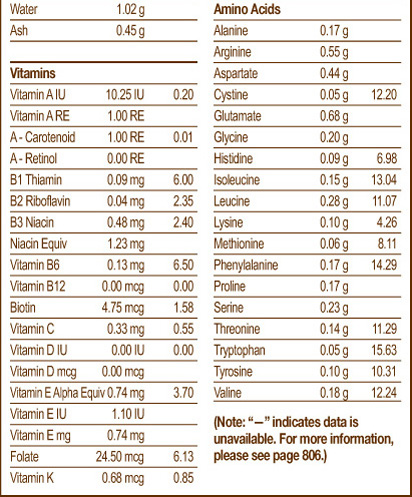
Walnuts are an excellent source of monounsaturated fats—approximately 15% of the fat found in Walnuts is healthful monounsaturated fat. A host of studies have shown that increasing the dietary intake of Walnuts has favorable effects on high cholesterol levels and other cardiovascular risk factors. Two recent studies compared individuals on a Mediterranean diet to those on a diet that contained the same calorie and fat content but where Walnuts were substituted for other monounsaturated fat-rich foods (such as olives and olive oil). It turns out that the individuals on the Walnut-rich diet showed lower levels of cardiovascular risk factors, including total cholesterol, LDL cholesterol, C-reactive protein and lipoprotein(a). In the study that measured arterial function, it was found to improve on the Walnut-rich diet.
The other cardio-protective nutrients for which Walnuts are a concentrated source include alpha-linolenic acid (ALA) and the amino acid l-arginine. Walnuts are an excellent source of omega-3 fatty acids in the form of ALA, which is a precursor to the EPA and DHA found in fish. Diets rich in ALA are associated with a reduced risk of heart disease as well as lower levels of cholesterol and triglycerides. Since Walnuts contain relatively high levels of the amino acid l-arginine, they may also be of special benefit when it comes to hypertension. In the body, l-arginine is converted into nitric oxide, a nutrient that helps keep the inner walls of blood vessels smooth and allows blood vessels to relax. (For more on plant-based Omega-3 Fatty Acids, see page 770.)
Promote Optimal Health
Walnuts are a good source of copper and manganese, two minerals that are essential cofactors in a number of enzymes important in antioxidant defenses. For example, the key oxidative enzyme superoxide dismutase requires both copper and manganese. Walnuts are also a concentrated source of phytonutrients with researchers recently identifying 16 polyphenols in Walnuts with powerful antioxidant activity, including three new tannins. One of these compounds is ellagic acid, which seems to block the metabolic pathways that can lead to cancer. Ellagic acid not only helps protect healthy cells from free radical damage, but also helps detoxify potential cancer-causing substances and helps prevent cancer cells from replicating.
Additional Health-Promoting Benefit of Walnuts
Walnuts are a concentrated source of sleep-promoting tryptophan.
While walnuts and flaxseeds are rich in a type of omega-3 fats, they may not serve as a good source of omega-3s overall for some people. Understanding some of the basic issues involved with walnuts and flaxseeds—and in fact, any kind of plant food—and omega-3 nourishment can help you to optimize your nutritional intake and your overall health.
While walnuts and flaxseeds are an excellent source of omega-3 fat, they only contain one basic member of the omega-3 fat family. Virtually all of the omega-3 fat is found in the form of alpha-linolenic acid (ALA).
The Omega-3 Assembly Line Starts With ALA
So that you can better understand how the fact that walnuts and flaxseeds feature a concentration of ALA impacts their potential ability to be an overall good source of omega-3s, let’s start with a basic chemistry review of the omega-3 family of fats.
Omega-3s are a very diverse group of fats. Yet, all of the members fall into a basic pattern that can be imagined as a kind of metabolic assembly line.
Fats can be measured in length according to the number of carbon atoms that they contain. ALA, which is concentrated in walnuts and flaxseeds, has 18 carbons, making it the shortest of the omega-3 fats, and hence the simplest. It retains a position at the beginning of the assembly line with our omega-3 metabolism starting with this compound as a building block.
ALA Gets Elongated Into Other Omega-3 Fatty Acids
If another pair of carbon atoms gets added on to ALA (a process called “elongation” in biochemistry, and a process that is carried out by enzymes called elongases), it gets ready to become EPA (eicosapentaenoic acid), another important member of the omega-3 family. If yet another pair of carbons are added to EPA, it gets ready to become DHA (docosahexaenoic acid), a third important member of the omega-3s.
ALA Gets Desaturated Into Other Omega-3 Fatty Acids
The reason we say that these omega-3 fats “get ready” to turn into other forms is because getting longer is not the only requirement for conversion of one omega-3 into another. A second requirement is what’s called “increased desaturation.” During this process, the omega-3 fat gets altered chemically so that its carbon atoms are connected together in a new way that provides more flexibility to the fat. This new kind of connection is called double-bonding. For ALA to become EPA, two new double bonds must be added in addition to the two-carbon-atom increase in length.
The Role of Other Nutrients in Omega-3 Metabolism
The process of lengthening and changing, of elongating and desaturating, the chemical bonds in omega-3 fat is complex, and many nutrients are required to bring it about. To get from ALA to EPA, for example, the required nutrients are vitamin B3, vitamin B6, vitamin C, zinc and magnesium.
Nutrient Deficiencies Can Block Omega-3 Metabolism
What happens if an individual is deficient in one or more of the above nutrients? The answer is simple: that individual cannot convert ALA very efficiently (or at all) into the other omega-3 fats that are longer. In severe deficiency, the critical omega-3 fats, EPA and DHA, could simply not be made. People with known deficiencies in most of the above nutrients (vitamins B3, B6 and C, and the minerals zinc and magnesium) would not be able to get maximum benefit from walnuts and flaxseeds because they would not be able to convert the ALA into the other omega-3 fats.
In the above situation, many healthcare practitioners would ask for an increase in the omega-3 supportive nutrients (the B-complex vitamins, vitamin C, zinc and magnesium), and at the same time, they would ask for a different source of omega-3s, such as preformed EPA and DHA from salmon and other fish, until the nutrient deficiencies were resolved. Yet, in cases where the assembly line seems to be functioning properly, many healthcare practitioners opt for walnuts and flaxseeds since providing the body with the compound that is at the beginning of the assembly line allows the body to best decide the exact types and proportions of omega-3s it wants to create.
almonds
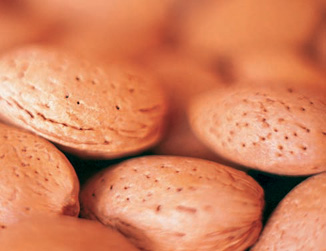
highlights

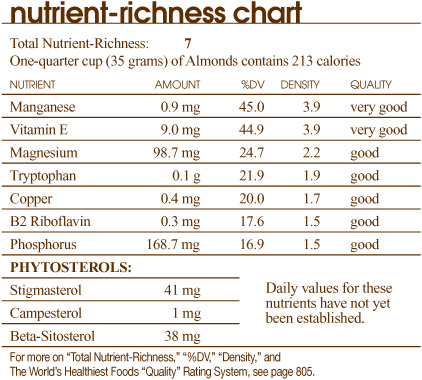
Almonds have been revered by cultures throughout history. In Biblical times, Almonds were held in high regard as among “the best fruits of the land.” The Romans considered them a sign of fertility, happiness and romance; they showered newlywed couples with Almonds for good health and fortune. In Israel, it is still common practice to plant an Almond tree as a memorial. Delicately flavored and versatile, Almonds can complement the flavors of almost any type of dish. They are satisfying, nutritious and easy to carry, making them the perfect snack and a great addition to your “Healthiest Way of Eating.”
why almonds should be part of your healthiest way of eating
Almonds are often referred to as “the King of Nuts” because of their high nutritional value. Nuts, such as Almonds, have actually received qualified health claim (QHC) status from the U.S. Food and Drug Administration, in recognition that eating 1.5 ounces (of most nuts) per day will provide special health benefits. Almonds are a very good source of vitamin E and, like other varieties of nuts, are a concentrated source of monounsaturated fats, which make them a very good food for a healthy heart. (For more on the Health Benefits of Almonds and a complete analysis of their content of over 60 nutrients, see page 538.)
varieties of almonds
Almonds (Prunus amygdalu) were thought to have originated in regions of western Asia and North Africa. The Almond that we think of as a nut is technically the seed of the fruit of the Almond tree, a medium-size tree that bears fragrant pink and white flowers. Like its cousins, the peach, cherry and apricot trees, the Almond tree bears fruits with stone-like seeds (or pits) within. The seed of the Almond fruit is what we refer to as the Almond nut. Almonds are off-white in color, covered by a thin brownish skin, and encased in a hard shell. They are classified into two categories: sweet and bitter.
SWEET ALMONDS
These are the edible variety of Almonds. They are oval in shape with a wonderfully buttery taste. They are available in markets in their shell or with their shell removed. Shelled Almonds are available whole, sliced or slivered in either their natural form with their skin or blanched with their skin removed. This is the variety featured in the photographs in this chapter.
Jordan Almonds
A Mediterranean variety imported from Spain. It has a semi-hard shell and a rich, sweet Almond flavor. It is the most popular variety of sweet Almonds.
Nonpareil
A variety cultivated in California that has a paper thin shell.
BITTER ALMONDS
These are used to make Almond oil, a flavoring agent for foods and liqueurs such as Amaretto. They are otherwise inedible as they naturally contain toxic substances such as hydrocyanic acid. These compounds are removed in the manufacturing process.
GREEN ALMONDS
The seed inside these furry green fruits is the actual Almond. When mature Almonds are harvested, the fruit portion is discarded, but when they are green, they can be eaten and have the crunch and taste of an unripe peach. At this stage, the seed or Almond has not yet hardened and is soft and jelly-like.
the peak season
Almonds in the shell are the freshest and can be found most easily from fall to early winter. Packaged raw and roasted Almonds are available throughout the year.
biochemical considerations
Almonds are a concentrated source of oxalates, which might be of concern to certain individuals. (For more on Oxalates, see page 725.)
3 steps for the best tasting and most nutritious almonds
Enjoying the best tasting Almonds with the most nutrients is simple if you just follow my 3 easy steps:
1. The Best Way to Select
2. The Best Way to Store
3. The Best Way to Prepare
1. the best way to select almonds
Almonds that are still in their shells have the longest shelf life. I look for shells that are not split, moldy or stained. Shelled Almonds that are stored in a hermetically sealed container will last longer than those that are sold in bulk bins since their exposure to heat, air and humidity is reduced. As with all nuts, I recommend selecting organically grown varieties whenever possible. (For more on Organic Foods, see page 113.)
If I am going to buy Almonds from bulk bins, I always check to make sure that the store where I buy Almonds has a quick turnover of inventory and that the bulk containers are well sealed in order to ensure maximum freshness. The Almonds should be uniform in color and not limp or shriveled. They should also smell sweet and nutty; if their odor is sharp or bitter, they are rancid.
If you want Almonds with a roasted flavor and texture, choose ones that have been “dry roasted” as they are not cooked in oil. The commercial roasting process of nuts is often a form of deep-frying, usually in saturated fat, such as coconut or palm kernel oil. Deep-fried foods have been linked to high levels of LDL (the “bad” form of cholesterol) and to thickening of larger artery walls.
Even “dry roasted” Almonds may be cooked at high temperatures that damage their natural oils. It is important to read the label to be sure that no additional ingredients such as sugar, corn syrup or preservatives have been added. For the highest quality, least expensive “dry roasted” Almonds, it’s best to just roast them yourself using the “Healthiest Way to Dry Roast Almonds.” (See page 536.)
2. the best way to store almonds
Since Almonds have a high fat content, it is important to store them properly in order to protect them from becoming rancid. Store shelled Almonds in a tightly sealed container in a cool dry place away from exposure to sunlight. Keeping them cold will further protect them from rancidity and prolong their freshness. Refrigerated Almonds will keep for 6 months, while Almonds stored in the freezer can be kept for up to 1 year. Shelled Almond pieces will become rancid more quickly than whole shelled Almonds. Almonds still in the shell have the longest shelf life.
3. the best way to prepare almonds
Whole shelled Almonds can be chopped by hand or can be placed in a food processor. If using a food processor, it is best to pulse on and off a few times instead of running the blade constantly, as this will help ensure that you end up with chopped Almonds rather than Almond butter. To peel Almonds, “blanch” them by bringing a small amount of water to a boil. Add Almonds and simmer for just about 2 minutes. Drain and slip off peels.
Q If you eat the blanched variety of Almonds, do you still enjoy the same health benefits as if you ate those with the skin?
A While the blanched variety of Almonds will still provide you with many nutritional benefits, the skin does have additional properties. It is very rich in flavonoid phytonutrients that have powerful antioxidant properties. While there is some debate over the relationship between Almond skins, enzyme inhibitors and digestibility, I believe that Almond skins are worth eating as long as they don’t bring along with them any evidence of poor digestion or allergic reaction.
Q My friend told me that Almonds contain toxic compounds? Is that true?
A Almonds are generally grouped into two classifications: sweet Almonds (Prunus amygdaulus var. dulcis) and bitter Almonds (Prunus amygdalus var. amara). The former is the type that we commonly eat and refer to as an “Almond.” The latter is often used for its essential oil as the basis of almond essence for flavorings, including being used in the liqueur Amaretto. Yet, before extracting the oil from bitter Almonds, manufacturers have to remove the toxic substances that these Almonds contain. These substances include hydrocanic acid, which give these Almonds their bitter flavor. Potentially, it was these bitter Almonds to which your friend was referring.
STEP-BY-STEP RECIPES
The Healthiest Ways of Preparing Almonds
health benefits of almonds
Promote Heart Health
A high-fat food that’s good for your health? That’s not an oxymoron, it’s Almonds. In human feeding trials, substituting Almonds for more traditional fats has led to an 8–12% reduction of atherosclerosis-promoting LDL cholesterol. In addition, five large-scale human epidemiological studies all found that nut consumption is linked to a lower risk of heart disease.
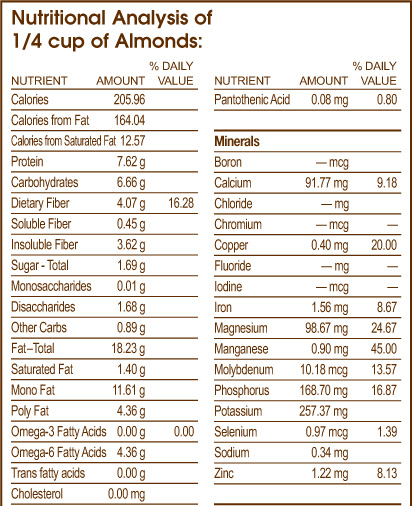
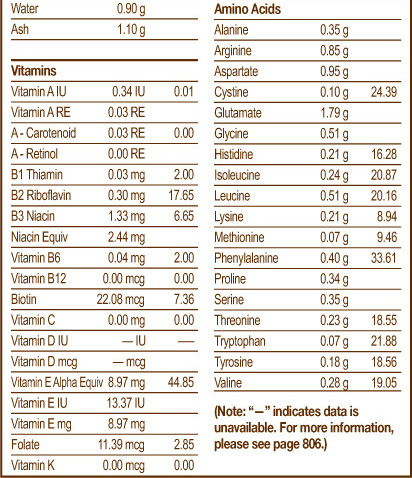
One reason that Almonds may promote heart health is that they are high in monounsaturated fats, the same type of health-promoting fats as are found in olive oil; monounsaturated fats have been associated with lower levels of LDL cholesterol as well as reduced risk of heart disease. Almonds are also a very good source of vitamin E, which may also help to explain their cardiovascular-health-promoting properties since this nutrient can help to stop LDL oxidation, a process linked to atherosclerosis.
Promote Healthy Weight
Preliminary research suggests that Almonds may benefit your waistline. Results from a recent study found that an Almond-enriched, low-calorie diet helped overweight individuals shed pounds more effectively than a low-calorie diet high in complex carbohydrates. Both test diets supplied the same number of calories and equivalent amounts of protein. Those eating Almonds experienced a 62% greater reduction in their weight/BMI (body mass index), 50% greater reduction in waist circumference and 56% greater reduction in body fat compared to those on the low-calorie, high-carbohydrate diet. Among those subjects who had type 1 diabetes, medication reductions were sustained or further reduced in 96% of those on the Almond-enriched diet versus in 50% of those on the complex carbohydrate diet.
Promote Digestive System Health
In an animal study of the effect of Almonds on colon cancer, animals were exposed to a colon cancer-causing agent and fed Almond meal, Almond oil, whole Almonds or a control diet containing no Almonds. The animals given whole Almonds showed fewer signs of colon cancer, including fewer rapidly dividing cells. One reason may be the dietary fiber that is concentrated in Almonds.
Almonds’ digestive health benefits may also extend to gallbladder health. Twenty years of dietary data found that women who eat at least one ounce of nuts, such as Almonds, or peanuts or peanut butter each week have a 25% lower risk of developing gallstones.
Additional Health-Promoting Benefit of Almonds
Almonds are also a concentrated source of other nutrients providing additional health-promoting benefits. These include bone-building magnesium, manganese, copper and phosphorus; energy-producing vitamin B2 and sleep-promoting tryptophan.
Q Can you please confirm that the Almond is actually a fruit, the seed of which we eat, as opposed to a nut?
What qualifies a nut as a real nut, and when is a nut really a fruit?
A The Almond that we think of as a nut is technically the seed of the fruit of the Almond tree, a medium-size tree that bears fragrant pink and white flowers. Like its cousins, the peach, cherry and apricot tree, the Almond tree bears fruits with stone-like seeds (or pits) within. The seed of the Almond fruit is what we refer to as the Almond nut.
Yet, when are other “nuts” really nuts and when are they something other than a nut? I think it first depends upon how you use the term. For example, tomatoes and avocados are technically and botanically considered fruits, but in “culinary language” we call them vegetables.
In the botanical sense, a nut is a dry fruit with one (or sometimes two) seeds produced by plants in the botanical order Fagales. These include walnuts, chestnuts and pecans. But not all “nuts” are commonly edible, such as the nuts from the stone-oak tree, which is very bitter.
In terms of a more culinary and common definition, an oil-containing seed or kernel contained in a shell is often known as a nut. It is this category that is obviously more inclusive and contains such “non-nuts” as Almonds, peanuts and Brazil nuts.
Q Do Almonds contain the “alpha tocopherol” type Vitamin E?
A Almonds contain a range of naturally occurring forms of vitamin E, including the alpha-tocopherols, gamma-tocopherols and tocotrienols. That’s one of the amazing benefits of eating a whole food—whole foods give us the widest variety of nutrients available.
Almonds are a very healthy food, providing good fats as well as important vitamins and minerals. Yet, a lot of a good thing is not necessarily a good thing. Eating that many almonds may stand in your way of losing a few pounds depending upon what the rest of your diet is like and what your overall caloric intake is.
Each cup of almonds contains 824 calories. Since reducing caloric intake by 3,500 calories would be associated with one pound of weight loss, reducing your intake of almonds but maintaining your current dietary intake would allow you to lose weight. For example, by cutting down to one-quarter cup of almonds each day you would reduce your caloric intake by 618 calories, which would allow you to lose one pound in about six days.
There is actually not a fixed amount of almonds that would be allowed or not allowed on a person’s diet. The right amount depends upon the rest of the food consumed. Is there room in the diet for much fat? What vitamins and minerals are needed? Do almonds contain the nutrients that are needed? Unless you know the answers to these questions, you cannot make a helpful decision about the right amount of almonds to eat.
If these kinds of questions are unfamiliar to you, you may want to meet with a healthcare practitioner, such as a nutritionist, who can help you evaluate your nutritional needs. In general, it would be unusual to balance a diet that contained more than one-third cup of almonds. That amount would provide 275 calories and 24 grams of fat. The 275 calories would be about 14% of a 2,000-calorie diet—about as much as most people would want from a single food. But once again, these numbers are only a general description and cannot help you decide exactly what nutrients you need.
If you find that that you are eating that many almonds because you are a “boredom eater,” you are definitely not alone. Many people eat to keep themselves occupied and to have a hand-to-mouth activity.
If you wanted to cut back on your almond snacking, I would suggest snacking on other foods that are lower in calories and that would provide other nutrients not provided by the almonds. For example, vegetables are a great snack. Some of my favorites are broccoli, carrots, cucumbers, bell peppers…the list goes on and on. The great thing about vegetables is that they take a while to chew and are very filling, while being nutrient-rich and low in calories.
peanuts

highlights

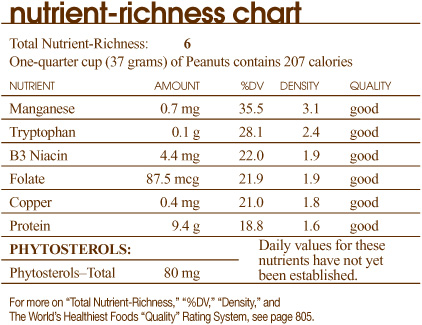
Two individuals in the 19th century popularized Peanuts in the United States, and since that time, they have become ubiquitous in American culture. George Washington Carver not only invented more than 300 uses for Peanuts, he was instrumental in encouraging farmers to plant Peanuts when the boll weevil plague destroyed their cotton crops after the Civil War. During this same period, a St. Louis physician created a groundup paste made from Peanuts and prescribed this nutritious, high-protein, low-carbohydrate food to his patients—this was the precursor to the all-American favorite, Peanut butter!
why peanuts should be part of your healthiest way of eating
Peanuts are another great way to add heart-healthy monounsaturated fats to your “Healthiest Way of Eating.” They are also known for their resveratrol content, which contributes to Peanuts’ antioxidant and anti-inflammatory properties. Peanuts are also rich in niacin and folate, two B vitamins that are also important for a healthy heart. (For more on the Health Benefits of Peanuts and a complete analysis of their content of over 60 nutrients, see page 544.)
varieties of peanuts
Peanuts originated in South America where they have existed for thousands of years. Technically, Peanuts are not nuts. They are, in botanical fact, legumes and are related to other foods in the legume family including peas, lentils, chickpeas and other beans. Their botanical name is Arachis hypogeae.
Peanuts grow in a very fascinating manner. They actually start out as an above ground flower that, due to its heavy weight, bends towards the ground. The flower eventually burrows underground, which is where the Peanut matures. The veined brown shell or pod of the Peanut contains two or three Peanut kernels. Each oval-shaped kernel or seed is comprised of two off-white lobes that are covered by brownish-red skin. Peanuts have a hardy, buttery and “nutty” taste.
Due to their high protein content and sweet, nutty taste, Peanuts are processed into a variety of different forms, including butter, oil, flour and flakes; some are oil roasted, dry roasted or blanched. While there are many varieties of Peanuts, the ones most commonly found in the marketplace include:
VIRGINIA
This variety is sold in the shell.
SPANISH
Small with reddish-brown skin.
VALENCIA
Sweeter, with the shell having three or four kernels inside. Popular in the South as it is mostly used for making boiled Peanuts.
the peak season available year-round.
biochemical considerations
Peanuts are a concentrated source of oxalates and goitrogens, which might be of concern to certain individuals. Peanuts are one of the foods most commonly associated with allergic reactions. (For more on Oxalates, see page 725; Goitrogens, see page 721; and Food Allergies, see page 719.)
3 steps for the best tasting and most nutritious peanuts
Enjoying the best tasting Peanuts with the most nutrients is simple if you just follow my 3 easy steps:
1. The Best Way to Select
2. The Best Way to Store
3. The Best Way to Prepare
1. the best way to select peanuts
Shelled Peanuts are generally available in prepackaged containers as well as bulk bins. Peanuts stored in a hermetically sealed container will last longer than those sold in bulk since their exposure to heat, air and humidity is reduced. If I am going to buy Peanuts from bulk bins, I always check to make sure that the store where I buy Peanuts has a quick turnover of inventory and that the bulk containers are well sealed in order to ensure maximum freshness. Whether purchasing Peanuts in bulk or in a packaged container, make sure that no evidence of moisture or insect damage is present. It is best to smell Peanuts, if possible, to ensure they do not have a rancid or musty odor.
Whole Peanuts still in their shell are usually available in bags or in bulk bins. If possible, I pick up a Peanut and shake it, looking for two signs of quality: (1) it should feel heavy for its size and (2) it should not rattle since a rattling sound suggests that the Peanut kernels have dried out. Additionally, the shells should be free from cracks, dark spots and insect damage. As with all nuts, I recommend selecting organically grown Peanuts whenever possible. (For more on Organic Foods, see page 113.)
If you want Peanuts with a roasted flavor and texture, choose ones that have been “dry roasted” as they are not cooked in oil. The commercial roasting process of nuts is often a form of deep-frying, usually in saturated fat, such as coconut or palm kernel oil. Deep-fried foods have been linked to high levels of LDL (the “bad” form of cholesterol) and to thickening of larger artery walls.
Even “dry roasted” Peanuts may be cooked at high temperatures that damage their natural oils. It is important to read the label to be sure that no additional ingredients such as sugar, corn syrup or preservatives have been added. For the highest quality, least expensive “dry roasted” Peanuts, it’s best to just roast them yourself using “The Healthiest Way to Dry Roast Peanuts” (see page 542).
2. the best way to store peanuts
Shelled Peanuts should be stored in a tightly sealed container in the refrigerator or freezer since excess exposure to high temperatures, humidity or light will cause them to become rancid. Shelled Peanuts will keep in the refrigerator for about 6 months and in the freezer for up to 1 year. To prevent potential oxidation, it is best to chop Peanuts right before eating or using in a recipe rather than in advance. Chopping increases the amount of surface area that has contact with the air, which can increase the amount of oxidation.
Peanuts still in their shells can be kept in a cool, dry dark place, while keeping them in the refrigerator will extend their shelf life. Peanut butter should always be refrigerated once opened.
How Proper Storage can Help Reduce the Growth of Aflatoxins
It is important to ensure that Peanuts are stored properly in a dry, cool environment to prevent the growth of aflatoxin, a toxic carcinogen produced by fungus that grows at temperatures of 86–96°F (30–36°C) and when the humidity is high. To help prevent aflatoxin ingestion, the FDA enforces a ruling that 20 parts per billion is the maximum aflatoxin permitted in all foods and animal foods, including Peanut butter and other Peanut products. Better storage and handling methods have virtually eliminated the risk of aflatoxin ingestion.
3. the best way to prepare peanuts
Shelled Peanuts can be chopped by hand using a knife and a cutting board or using a food processor. If using a food processor, it is best to pulse on and off a few times, instead of running the blade constantly, as this will help ensure that you end up with chopped Peanuts rather than chunky Peanut butter. If Peanut butter is what you want, grind Peanuts in a food processor until you have achieved the consistency you like.
Q Does packaged nut milk provide the same health benefits as whole nuts?
A Commercially purchased, prepackaged nut milk does not provide nearly the same benefits as whole nuts. It’s not even close!
The first ingredient in most nuts milks is either water or “nut base.” The latter generally refers to some form of blenderized and filtered nut water. Exactly how much nuts are contained in this “nut base” varies from manufacturer to manufacturer. However, if you check the fiber content of your nut milk, that number will give you some clue about the likely amount of nuts involved. For example, there’s about one gram of fiber in every seven almonds. Many almond milks contain zero grams of fiber per eight ounces! This is not to say that nut milks can’t play a role in your “Healthiest Way of Eating” but rather to point out that they do not offer the same benefits that can be enjoyed by eating the nuts from which they were derived.
STEP-BY-STEP RECIPES
The Healthiest Ways of Preparing Peanuts
health benefits of peanuts
Promote Heart Health
Peanuts are rich in monounsaturated fats, the type of fat that is emphasized in the heart-healthy Mediterranean diet. Studies of diets with a special emphasis on Peanuts have shown that this little legume is a big ally for a healthy heart. In one study, a high-monounsaturated diet that emphasized Peanuts and Peanut butter decreased cardiovascular disease risk by an estimated 21% compared to the average American diet.
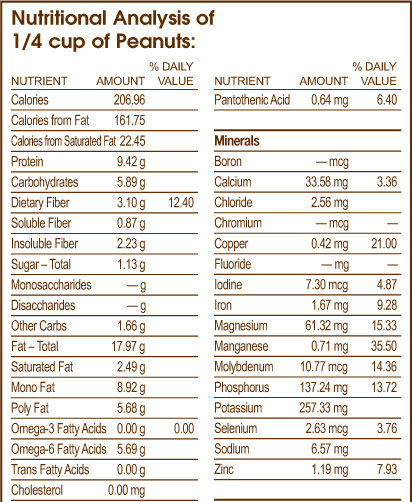
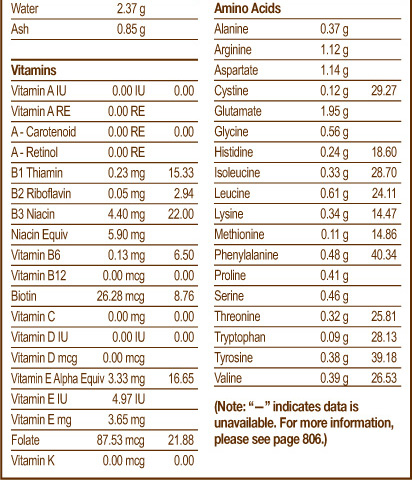
In addition to their monounsaturated fat content, Peanuts feature an array of other nutrients that, in numerous studies, have been shown to promote heart health. Peanuts are good sources of niacin and folate. In addition, Peanuts provide resveratrol, the phenolic antioxidant also found in red grapes and red wine that is partially thought to be responsible for the French paradox: the fact that in France people consume a diet that is high in fat, but have a lower risk of cardiovascular disease compared to those in the United States. Peanuts are also packed with phytosterols, phytonutrients that help to reduce cholesterol levels. With all of the important nutrients provided by Peanuts, it is no wonder that numerous research studies have found that frequent Peanut consumption is related to reduced risk of cardiovascular disease.
A Good Source of Protein
Peanuts are a good source of low-cost high-quality protein. We rely on dietary protein for our supply of amino acids. Our bodies use amino acids for a multitude of functions, including manufacturing muscles, tissues, enzymes and nutrientcarrying protein molecules.
Promote Brain Health
Recent research suggests that regular consumption of niacin-rich foods, like Peanuts, provides protection against age-related cognitive decline. When researchers tested thousands of individuals aged 65 years and older, they found that those who got the most niacin from their food were 70% less likely to have developed Alzheimer’s disease than those consuming the least; their rate of age-related cognitive decline was also significantly less.
Promote Digestive Health
A landmark 20-year study has shown that women who eat at least one ounce of nuts, Peanuts or Peanut butter each week have a 25% lower risk of developing gallstones. Since one ounce is only about 30 nuts or about two tablespoons of nut butter, preventing gallbladder disease may be as easy as packing one Peanut butter and jelly sandwich (be sure to use whole wheat bread for its fiber, vitamins and minerals) for lunch each week.
Additional Health-Promoting Benefits of Peanuts
Peanuts are also a concentrated source of other nutrients providing additional health-promoting benefits. These nutrients include free-radical-scavenging copper and manganese and sleep-promoting tryptophan.
The World’s Healthiest Foods have detoxifying and cleansing properties. By eating nutrient-rich foods, such as the World’s Healthiest Foods, our body is able to cleanse and regenerate all the time. That’s because these foods contains abundant amounts of the full range of health-supportive nutrients. Unlike processed foods that are nutrient depleted and may rob your body of nutrients in order to digest them, nutrient-rich whole foods provide additional nutrients so that your body can continually support itself. Plus, since they do not contain synthetic additives, and notably if they are organically grown and do not have pesticide residues, they won’t have these toxins that your body needs to detoxify. Therefore, I think it’s important to remember that eating nutrient-rich foods and following the “Healthiest Way of Eating” is probably the best thing you can do if you are interested in detoxifying and cleansing your body.
World’s Healthiest Foods Help with Cleansing and Detoxification
Salads and green leafy vegetables are some of the best foods included among the World’s Healthiest Foods to help cleanse and detoxify the body. They can help remove wastes, reduce acids in the body, alkalize the body and control obesity by reducing excess body fat. The chlorophyll found in salads and green leafy vegetables may help cleanse and purify the blood and boost the immune system.
Here’s how some of the other World’s Healthiest Foods can assist with cleansing and detoxification:
• Lemon juice detoxifies and cleanses the digestive tract and balances pH
• Cilantro can detoxify and reduce mercury levels
• Prunes help cleanse and detoxify the digestive system and help prevent constipation
• Grains, high in fiber, cleanse the digestive tract
• Fibers such as beta-glucan, found in oats and barley, help eliminate excess cholesterol
By placing special emphasis on enjoying the World’s Healthiest fruits and vegetables to help cleanse and detoxify your body, you will start to feel cleaner and lighter, become more mentally clear and have more energy.
Detoxification
Our body has a wide variety of processes for helping us eliminate potential toxins. Some of those processes take place in our digestive tract. Others take place in our skin, our lymphatic vessels and our liver. We’re able to sweat out certain toxins, breathe out certain toxins, and, of course, excrete toxins in our urine or in a bowel movement. It’s important not to overlook the role of any detox process if you are considering any kind of “cleanse,” even if you plan to make dietary changes the center of your cleansing plan. Most of the toxins found in food are fat soluble, and if they cannot be eliminated directly in a bowel movement, they are sent from our digestive tract to our liver for detox processing. When you want to cleanse your body of food toxins, it’s therefore important to have optimal digestive and liver support. These two organ systems—your liver and your digestive tract—are especially important when it comes to cleansing and detoxification.
How the Liver Detoxifies Potentially Harmful Chemicals
There are usually two steps required for the liver to detoxify a potentially harmful chemical. Since many potential toxins are fat soluble, the liver cells must typically turn these fat-soluble substances into water-soluble substances in order for them to be excreted from the body. This conversion process requires two steps. In the first step, the potential toxin is made more chemically reactive. In the second step, this more reactive form of the substance is chemically combined with another molecule, creating a new substance that is water soluble and can be excreted from the body. The first step often requires a good supply of antioxidant nutrients, including vitamins C and E, flavonoids and other molecules. The second step requires a good supply of amino acids (the building blocks of protein) together with other unique nutrients that are sometimes overlooked in the world of nutrition.
Sulfur Is Especially Important In Detox and Cleansing
The mine\ral sulfur is critical for the detoxification of many potential toxins. Sulfur-rich foods can therefore be a mainstay in detox support. The Allium vegetables—onions, garlic and leeks—are all great sources of sulfur. So are the cruciferous vegetables including broccoli, cauliflower and Brussels sprouts. In fact, one of the most well-known crucifers, cabbage, has been found to be so health-promoting in its ability to support the liver that one study suggested that it was this common vegetable that was responsible for protecting women from developing breast cancer in a study that explored the reasons why women emigrating from Poland to the United States dramatically increased their risk of breast cancer. It turns out that eating cabbage was one of the dietary habits they left behind when they emigrated. Their intake of cabbage once they began living in the United States dropped to one-third of their typical amount while their risk of breast cancer rose 300%! (For more on this topic, see page 153.)
cashews
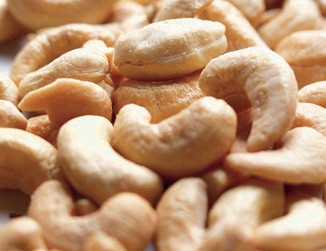
highlights

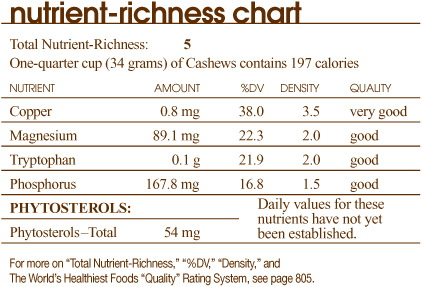
Cashews are indigenous to the Americas but are widely cultivated in India and Africa. Surprisingly, they belong to the same family as mangos as well as other nuts such as pistachios. Cashews are a great out-of-hand snack, making them an easy addition to your “Healthiest Way of Eating.” They go well in salads, add rich, buttery flavor and extra nutrition to sautéed dishes and can be ground into healthy and delicious Cashew butter.
why cashews should be part of your healthiest way of eating
Cashews are a tasty heart-healthy food. They have a lower fat content than most other nuts with approximately 58% of their total fat being oleic acid, the heart-healthy monounsaturated fat that has made olive oil famous. They are extremely rich in copper, important for supporting joint integrity, and magnesium, a mineral essential for both bone and heart health. (For more on the Health Benefits of Cashews and a complete analysis of their content of over 60 nutrients, see page 548.)
varieties of cashews
The true fruit of the Cashew tree is the nut that encases the inner kidney-shaped kernel we enjoy as Cashews. From one end of the nut develops a plump, fleshy, pear-shaped “pseudofruit,” or false fruit, because it is easily mistaken for the fruit of the tree; it is known as the Cashew apple. Juicy and fibrous with an acidic taste, Cashew apples, while not widely known in the United States, are regarded as delicacies in Brazil and the Caribbean. Cashews are known botanically as Anacardium occidentale.
the peak season available year-round.
biochemical considerations
Cashews are a concentrated source of oxalates, which might be of concern to certain individuals. (For more on Oxalates, see page 725.)
3 steps for the best tasting and most nutritious cashews
Enjoying the best tasting Cashews with the most nutrients is simple if you just follow my 3 easy steps:
1. The Best Way to Select
2. The Best Way to Store
3. The Best Way to Prepare
1. the best way to select cashews
Cashews are generally available in prepackaged containers as well as bulk bins. Cashews stored in a hermetically sealed container will last longer than those sold in bulk since their exposure to heat, air and humidity is reduced. If I am going to buy Cashews from bulk bins, I always check to make sure that the store where I buy Cashews has a quick turnover of inventory and that the bulk containers are well sealed in order to ensure maximum freshness. The Cashews should be uniform in color and not limp or shriveled. They should also smell sweet and nutty; if their odor is sharp or bitter, they are rancid. As with all nuts, I recommend selecting organically grown Cashews whenever possible. (For more on Organic Foods, see page 113.)
If you want Cashews with a roasted flavor and texture, choose ones that have been “dry roasted” as they are not cooked in oil. The commercial roasting process of nuts is often a form of deep-frying, usually in saturated fat, such as coconut or palm kernel oil. Deep-fried foods have been linked to high levels of LDL (the “bad” form of cholesterol) and to thickening of larger artery walls.
Even “dry roasted” Cashews may be cooked at high temperatures that damage their natural oils. It is important to read the label to be sure that no additional ingredients such as sugar, corn syrup or preservatives have been added. For the highest quality, least expensive “dry roasted” Cashews, it’s best to just roast them yourself the using “The Healthiest Way to Dry Roast Cashews.” (See below.)
2. the best way to store cashews
Due to their high content of oleic acid, the oils in Cashews are more stable than those in most other nuts; however, Cashews should still be stored in a tightly sealed container in the refrigerator, where they will keep for about 6 months, or in the freezer, where they will keep for about 1 year. Cashew butter should always be refrigerated once it is opened.
3. the best way to prepare cashews
Whole shelled Cashews can be chopped by hand or can be placed in a food processor. If using a food processor, it is best to pulse on and off a few times, instead of running the blade constantly, as this will help ensure that you end up with chopped Cashews rather than Cashew butter.
health benefits of cashews
Promote Heart Health
Not only do Cashews have a lower fat content than most other nuts, but approximately 76% of their total fat is unsaturated fatty acids, with 76% of their unsaturated fatty acid content being oleic acid, the same heart-healthy monounsaturated fat found in olive oil. Studies show that oleic acid promotes good cardiovascular health, even in individuals with diabetes. Studies of diabetic patients show that monounsaturated fat, when added to a low-fat diet, can help to reduce high triglyceride levels. Cashews are also a good source of magnesium, a mineral that helps regulate nerve and muscle tone. As such, insufficient magnesium has been found to contribute to high blood pressure and muscle spasms (including spasms of the heart muscle). Additionally, Cashews are rich in phytosterols, phytonutrients that help to block cholesterol absorption and lower cholesterol levels in the body.
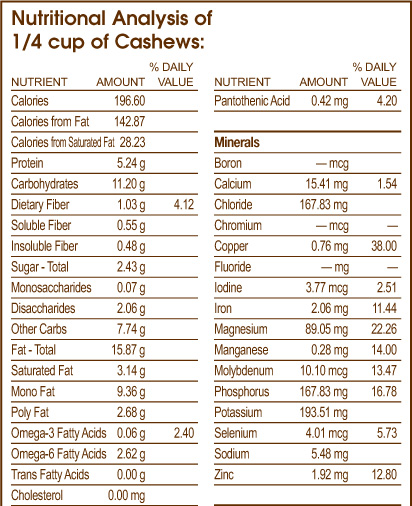
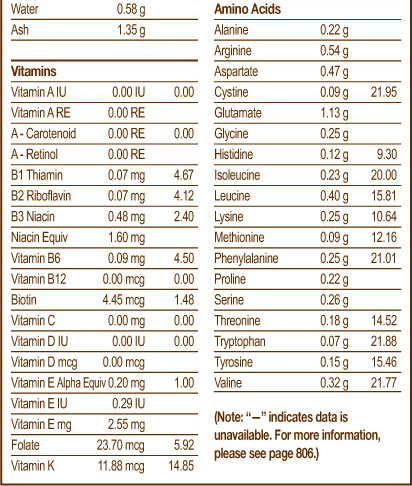
Promote Bone Health
Cashews are rich in nutrients that help to maintain bone density. As noted above, they are a good source of magnesium. This mineral helps to give bone its physical structure. It is part of the crystal lattice that serves as “scaffolding” that supports the integrity of bone. Also part of this crystal lattice is the mineral phosphorus of which Cashews are a good source. Phosphorus binds with calcium to form calcium phosphate, a component of hydroxyapatite, a mineral complex that gives bones strength and structure. Additionally, Cashews are a very good source of copper, which is a cofactor of enzymes necessary for proper bone metabolism.
Promote Digestive Health
Twenty years of dietary data collected on tens of thousands of women shows that women who eat at least one ounce of nuts, peanuts or peanut butter each week have a 25% lower risk of developing gallstones. Since one ounce is only about 30 nuts, preventing gallbladder disease may be as easy as having a handful of Cashews as an afternoon pick-me-up at least once a week.
Additional Health-Promoting Benefits of Cashews
Cashews are also a concentrated source of sleep-promoting tryptophan.
STEP-BY-STEP RECIPE
The Healthiest Way of Preparing Cashews
poultry & lean meat

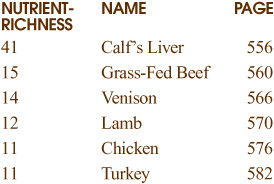
The numbers beside each food indicate their Total Nutrient-Richness. (For more details, see page 805.)
poultry & lean meat

Poultry and lean meat can play an important role in the “Healthiest Way of Eating” for many people. A look at their nutritional profiles will quickly show you how these foods are incredibly concentrated sources of many nutrients, including zinc, iron and vitamin B12, which are more difficult to find in plant-based foods. Poultry and lean meat also provide complete protein, which means that they contain all of the amino acids required by the body.
There are two different forms of iron contained in the foods that we eat. Heme iron is found only in animal foods. About 40% of the iron in meat comes in the form of heme iron. Non-heme iron is found in both plant and animal foods. Studies on iron absorption have found that anywhere from 15–35% of heme iron can be absorbed by the body, whereas only 3–8% of non-heme iron is absorbed. This is another reason why poultry and lean meat in moderation may serve as an important dietary consideration for some people.
I believe that by including poultry and lean meat as a balanced part of a meal, as opposed to making them the main focus of the meal, you can enjoy their nutritional benefits while still subscribing to the “Healthiest Way of Eating.”
Poultry and Lean Meat: Definition
While the term poultry refers to any domesticated fowl, the two types of poultry that are included among the World’s Healthiest Foods are chicken and turkey.
When I refer to lean meat, I mean the flesh and/or organ of a land animal that is consumed as food (not including poultry). Grass-fed beef, venison, lamb and calf’s liver are the meats included among the World’s Healthiest Foods.
Importance of Organically Raised Poultry and Lean Meat
I recommend purchasing organically raised poultry and lean meat whenever possible. This is because commercially raised poultry and meat are usually infused with hormones, antibiotics and other drugs, and their diet is composed of conventionally grown grains that have been sprayed with pesticides. The concern is that residues from the use of antibiotics, hormones and feed pesticides can remain in the flesh and organs of commercially raised poultry and meat.
Organically raised poultry and lean meat, however, are not exposed to antibiotics and growth hormones and are fed a wholesome diet of organically raised foods. This leads to healthier muscles (the part of the “meat” that we eat) that also contain more moisture. They are also raised in a more humane manner in a less stressful environment, which may account for reduced levels of circulating hormones and may be the reason that many people feel they have a richer flavor than their conventionally raised counterparts. Organically raised poultry and meat are “certified organic” by the USDA. When you eat organically raised poultry and meat, you can feel confident that they are “safer” and “healthier.”
Fats, Saturated Fats and Cholesterol
Poultry and meat may be of concern because of their high levels of saturated fats and cholesterol; however, it is possible to enjoy these foods and still maintain a low-fat diet. One way to do this is to always use lean cuts of meat. The cuts surrounding the back leg bone are usually the leanest because the back legs of the animal have become more muscular, and muscular meat contains less fat. It is also easy to remove visible fat from some cuts of meat, as is the case with the fat found on lamb chops. The fat in chicken and turkey is found primarily in the skin; it can be easily removed, which reduces the fat content significantly. Venison is one of the leanest meats available and calf’s liver has virtually no fat.
Poultry: Chicken and Turkey
Chicken and turkey are both versatile and inexpensive. Chicken is the public’s number one choice for animal food in the United States; we now eat more chicken than red meat. You can add chicken to salads, sandwiches, BBQs, stir-fries, sautés—the list goes on and on.
In 1970, 50% of all turkey was consumed during the holidays. Today, turkey is no longer reserved just for Thanksgiving and Christmas. With new cuts of turkey that are versatile and easy to prepare, you can enjoy turkey any time of the year. You can also find organic turkeys in many local markets. In addition to being delicious, turkey is also very versatile. There is a wide variety of turkey parts available (breasts, wings and thighs), so you can enjoy this food without having to roast an entire turkey.
CHICKEN AND TURKEY SKIN
Removing the skin and visible fat from chicken and turkey can lower the fat content by about 50%! Since the skin of chicken and turkey is the major contributor of saturated fat and cholesterol, removing the skin is a good technique to reduce the fat content of chicken and turkey for people who are trying to eat lean.
The breast is the leanest portion of poultry, and removing the skin from a four-ounce serving of boneless chicken breast reduces the fat content from 8.8 grams to 4.0 grams. Four ounces of turkey breast without skin has less than 1 gram of fat. With the skin removed, both chicken and turkey have considerably less fat than beef, which has 1.5 grams for a four-ounce serving.
WHEN TO REMOVE SKIN
I suggest cooking poultry with the skin on and removing it after cooking. This method does not significantly raise the fat content of the meat compared to cooking it with the skin removed. Skin will keep the meat insulated, allowing it to retain more of its natural moisture and flavors. This is particularly important when cooking the breast portion of poultry, which can easily become dry and tough. When you peel off the skin, the meat may look fatty; this is not actually fat, but moisture.
Grass-Fed Beef
Grass-fed beef is beef that has been only fed grass and allowed to roam freely in green pastures. I have three suggestions when it comes to eating meat, including beef, all of which are principles that I discuss throughout the book. First, beef should be eaten in moderation, as a component of a meal and not its main focus. Second, always try to choose the leanest cut of beef, when possible. These cuts are generally from the back leg (round) bone and include top round, bottom round and eye of round. Third, I believe that beef should be grass-fed and/or organically raised whenever possible. To me, this is extremely important not only for humanitarian and environmental reasons, but for reasons of personal health.
Because beef can be high in fat and cholesterol, it may not be the best choice for individuals watching their fat intake and their cholesterol levels. Some individuals also report having difficulty digesting beef.
Lamb
Many people still desire the rich taste of red meat, wanting an alternative to chicken and turkey, yet don’t want to eat beef. Lamb is a delicious red meat that fits well in numerous recipes and provides intensity of flavor and texture. Lamb is one of the finest tasting meats available and can be even more tender and flavorful than beef when properly prepared.
One of lamb’s nutritional signatures is that it is one of the best dietary sources of carnitine. This amino acid plays many important physiological functions including providing special benefits to the heart, transporting fatty acids into the mitochondria (the energy producing areas of the cell) and converting these fats into energy. Since much of this energy is used to fuel the muscles, athletes are usually especially interested in ensuring that their diet supplies them with adequate carnitine.
Calf’s Liver
Calf’s liver has virtually no fat. It is a good source of protein and is very rich in vitamin B12, zinc, iron and powerful antioxidants such as vitamin A, vitamin C and selenium. Selecting organic calf’s liver whenever possible provides the greatest assurance that the liver is free of pesticides, hormones and antibiotics. Calf’s liver is also more tender and has better flavor than beef liver.
Venison
Domesticated venison does not have the gamey flavor of wild venison and is becoming more readily available at the market. Domesticated venison is one of the leanest varieties of meats you can find.
Enjoy Poultry and Lean Meat, But in Moderation
1 recommend moderation and smaller portions of meat and poultry as the way to include these foods into your “Healthiest Way of Eating.” Because a healthy diet is a diverse diet, I feel that meat and poultry can be enjoyed in moderate amounts and not relied upon as the main protein source of every meal. For example, instead of 8 ounces of chicken surrounded by a 1/2 cup each of vegetables and grains for dinner, I would suggest 4 ounces of chicken, 2 cups of vegetables and 1 cup of squash or brown rice. For most people, poultry and lean meat can be incorporated into their “Healthiest Way of Eating” by enjoying 3–4 servings per week. The serving size is 3–4 ounces, with skin removed from poultry and fat trimmed from meat.
How to Use the Individual Poultry and Lean Meat Chapters
Each Poultry and Lean Meat chapter is dedicated to one of the World’s Healthiest Poultry and Lean Meats and contains everything you need to know to enjoy and maximize its flavor and nutritional benefits. Each chapter is organized into two parts:
1. POULTRY AND LEAN MEAT FACTS describes each food and its different varieties and presents its unique nutritional profile. It also addresses biochemical considerations of each by describing unique compounds that may be potentially problematic for individuals with specific health problems. Detailed information of the health benefits of each of these foods can be found at the end of the chapter.
2. THE 4 STEPS TO THE BEST TASTING AND MOST NUTRITIOUS POULTRY AND LEAN MEAT include information on how to select, store, prepare and cook each one of the World’s Healthiest Poultry and Lean Meats. While the 4 Steps provided in this Introduction can be used as an overview, more detail about the individual foods can be found in their dedicated chapters.
1. the best way to select poultry and lean meat
It is worth seeking out the best quality poultry and lean meat. I recommend selecting organically raised poultry and meat whenever possible because not only do they have the best flavor, but they are better for you (as well as the environment). By buying organic, you can reduce your exposure to the residues of hormones, antibiotics, pesticides and other chemicals that are found to be more concentrated in conventionally raised varieties. Additionally, in general, organically raised animals are raised in a more humane manner.
It is important to make sure that the poultry and lean meat you purchase are fresh, so try to find the packages with the latest use-by date or ask the staff at your market’s meat department to give you the freshest piece possible.
By talking to the people that work in the meat departments of your local markets and asking them about where and how often they get their poultry and meat, you can determine which stores have the freshest selection.
It is important to remember that different cuts of meat are better suited to different cooking methods and recipes; in each of the recipes, I specify which type of cut to use. If you have questions regarding cuts to use for other recipes, you should ask the staff person in your market’s meat department.
If you are having difficulties finding organically raised poultry and lean meats at your local supermarket or natural foods store, you may want to see if you can find a purveyor at your local farmer’s market (if you have one).
2. the best way to store poultry and lean meat
How you store your poultry and lean meat is important to maintain their freshness, flavor and texture. In general, keep poultry and meat in the meat section of the refrigerator; the temperature should be 36–40°F (2–4°C). Defrost frozen poultry and meat only in the refrigerator; never defrost at room temperature because it will thaw more quickly, creating conditions that promote bacterial growth.
3. the best way to prepare poultry and lean meat
Poultry and lean meat require minimal preparation. Rinse with cold water and pat dry.
4. the healthiest way of cooking poultry and lean meat
Below are some general tips that can be applied to cooking poultry and lean meat.
Healthy Cooking Times
Poultry and lean meat are easy to cook. Different cuts of poultry and meat require different cooking times for optimal flavor. Regardless of cooking method, if you overcook your poultry and meat, it will become dry and tough and lose its flavor. By not overcooking your poultry or meat, you will enjoy more flavor, moisture and nutrients. Each recipe in the chapters that follow has been created by considering the optimum cooking method and time for a particular cut of meat to give you the best results.
Healthy Cooking Methods
I have created quick, easy and healthy cooking methods that will seal in the juices and flavor of poultry and lean meat. Since these creative cooking methods do not require the use of any fats or oils, they will help to reduce your fat intake without compromising your enjoyment of flavor. Below are general descriptions of these cooking methods; more details can be found in the recipes in which these methods are used.
“QUICK BROIL”
The “Quick Broil” cooking method is a great technique that is very quick and easy. It is especially good for chicken breasts and lamb chops. It seals in moisture, creating meat that is juicy and flavorful. (For more on “Quick Broil,” see page 60.)
ROASTING
Roasting is used when you are cooking a larger piece of poultry or meat, such as a whole turkey or leg of lamb. It is very simple to do and produces meat that is infused with its own natural flavor and juices. (For more on “Roasting,” see page 61.)
“HEALTHY SAUTé”
If your recipe calls for poultry or meat cut into bite-size pieces sautéed with other ingredients (such as vegetables), you may want to use this cooking method. It cooks the poultry or meat quickly, requires no oil and makes a delicious simmering sauce. (For more on “Healthy Sauté,” see page 57.)
Cooking at High Temperature
High temperature cooking refers to cooking methods such as grilling and barbequing. When you use these methods, you will oftentimes notice that browning or charring occurs; this is a major source of carcinogenic compounds, known as heterocyclic amines (HCAs). These compounds are created from the interaction of the heat and the saturated fats contained in the meat. HCAs are found in cooked muscular meats and are very low or non-existent in liver and organ meats. It has been suggested that the consumption of meat cooked at high temperatures is linked to the development of certain types of chronic health conditions, including colon cancer.
Cooking methods that use lower temperatures such as “Healthy Sauté” form one-third less HCAs. Marinating meats in sauces that contain foods concentrated in antioxidant phytonutrients before broiling has also been shown to inhibit the production of HCAs; garlic-turmeric sauce and a mixture of olive oil, cider vinegar, garlic, mustard, lemon juice and salt are two examples of marinades that have been studied. Adding minced garlic to meat patties has also been found to reduce the development of HCAs. While vitamin C and citrus flavonoids act as antioxidants and have been shown to inhibit the activity of carcinogenic compounds, it has not been determined whether they will inhibit HCA formation; but at the very least, they will provide you with a delicious tasting meal with the potential of increased protection against HCAs.
calf’s liver

highlights

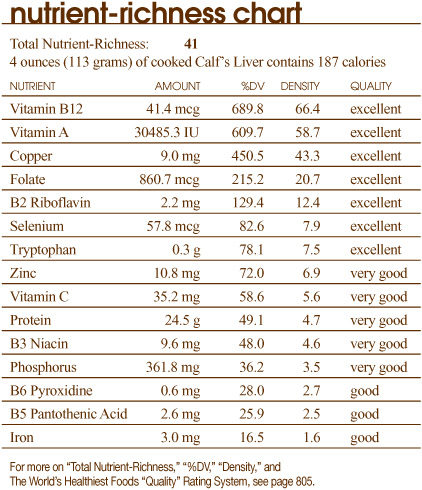
Although perhaps not a favorite of many people in the United States, liver is popular in cuisines in many other parts of the world. In European countries, including Italy, France, Austria and Germany, it is actually considered a delicacy. Fegato alla Veneziana (Venetian Liver) is one of the most famous dishes in the culinary history of the Italian city of Venice, while chopped liver is a mainstay of Jewish cooking. I would like to share with you how my quick and easy “Healthiest Way of Cooking” methods will help bring out the flavor and maximize the nutritional benefits of Calf’s Liver, so you can make it an enjoyable addition to your “Healthiest Way of Eating.”
why calf’s liver should be part of your healthiest way of eating
Lovers of Calf’s Liver hold it in high regard not only for its delicious taste and texture, but because of its tremendous storehouse of nutrients. Its nutritional profile clearly shows why it is included among the list of the World’s Healthiest Foods. Its wealth of B vitamins (especially vitamin B12) are important for a healthy heart, while its vitamin A and zinc help support the immune system; in addition, its vitamin C and selenium provide antioxidant protection against the oxidative damage to cells from free radicals. (For more on the Health Benefits of Calf’s Liver and a complete analysis of its content of over 60 nutrients, see page 558.)
varieties of calf’s liver
The Liver from a calf is more tender and has a more delicate flavor than beef liver. Calf’s Liver is from cows that are three to six months old, while beef liver is from animals six months and older. Calf’s Liver has a paler color than beef liver, is more tender and has a more delicate flavor. Beef liver is darker in color and has a strong flavor.
the peak season
Calf’s Liver is available year-round.
biochemical considerations
Calf’s Liver contains purines and oxalates. It also is a concentrated source of cholesterol (4 ounces contain 636 mg of cholesterol), which may be of concern to certain individuals. (For more on Purines, see page 727; and Oxalates, see page 725).
4 steps for the best tasting and most nutritious calf’s liver
Turning Calf’s Liver into a flavorful dish with the most nutrients is simple if you just follow my 4 easy steps:
1. The Best Way to Select
2. The Best Way to Store
3. The Best Way to Prepare
4. The Healthiest Way of Cooking
1. the best way to select calf’s liver
The best way to select Calf’s Liver is to first check the sell-by date on the label and choose the one with the latest date. Calf’s Liver should be shiny in appearance and have a pleasant smell. It is paler in color than beef liver and has a milder flavor.
It is particularly important to select Calf’s Liver from organically raised animals, whenever possible. Calves that were raised organically will not have been exposed to pesticides, hormones and antibiotics like their conventionally raised counterparts; therefore, their livers will have less exposure to and accumulation of these toxins. Buying organic Calf’s Liver will help assure you that you are feeding yourself and your family a delicious food from an animal that was raised in a more healthful and humane manner. (For more on Organic Meats, see page 565.)
Avoid Calf’s Liver that has any unpleasant odor or a package that has passed its expiration date.
2. the best way to store calf’s liver
Since Calf’s Liver is very perishable, it should always be either refrigerated or frozen. Refrigerate the Calf’s Liver in the original store packaging, if it is still intact and secure, as this will keep the amount of handling to a minimum. Calf’s Liver will keep in the refrigerator for only one or two days.
If you will be unable to cook the Calf’s Liver within one or two days of purchase, you can store it in the freezer, where it should keep for three to four months. Using a plastic freezer bag or freezer paper, wrap the Calf’s Liver carefully so that it is packaged as tightly as possible.
3. the best way to prepare calf’s liver
When handling raw Calf’s Liver, be extremely careful that it does not come in contact with other foods, especially those that will be served uncooked because raw meats can contain bacteria. In fact, you should use a separate plastic cutting board for meats. If you don’t use separate boards, make sure you wash your hands and cutting board very well with hot soapy water after handling Calf’s Liver. It is a good idea to add two TBS of bleach to two cups of water in a spray bottle and use this mixture to clean your cutting board. Spray your cutting board with this mixture and let it sit for 20 minutes to let the bleach evaporate.
4. the healthiest way of cooking calf’s liver
The “Healthiest Way of Cooking” Calf’s Liver is by using methods that will keep it moist and tender. Since liver can be easily overcooked and become dry, be sure to watch your cooking times. “Healthy Sauté” is the method I have found to be the best to prepare Calf’s Liver.
Methods Not Recommended for Cooking Calf’s Liver
COOKING WITH OIL
I don’t recommend cooking Calf’s Liver in oil because high temperature heat can damage delicate oils and potentially create harmful free radicals. (For more on Why it is Important to Cook Without Heated Oils, see page 52).
health benefits of calf’s liver
Promotes Heart Health
Calf’s Liver is an excellent source of vitamin B12 and folic acid and a good source of vitamin B6, three nutrients needed to convert artery-damaging homocysteine into other, benign molecules. Vitamin B2, of which Calf’s Liver is also an excellent source, is a cofactor in the reaction that regenerates glutathione, an antioxidant that protects lipids like cholesterol from free radical attack. Calf’s Liver is also an excellent source of the mineral selenium and a very good source of vitamin C, two potent antioxidants found to be associated with reduced risk of cardiovascular disease.
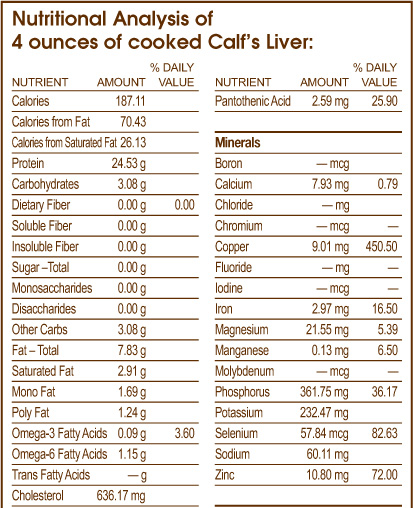
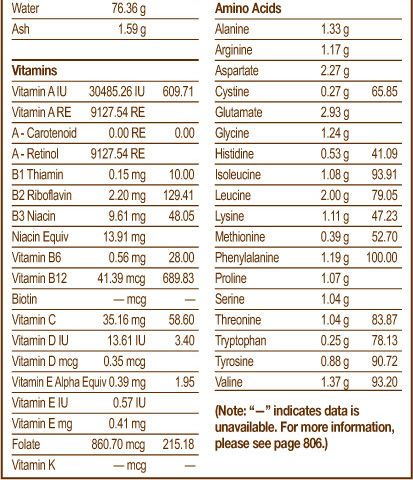
Promotes Optimal Immune Function
Calf’s Liver is an excellent source of vitamin A and a very good source of zinc, two nutrients that support the functioning of the immune system. Vitamin A is critically important for the health of epithelial and mucosal tissues, the body’s first line of defense against invading organisms and toxins. Zinc, the most critical mineral for immune function, acts synergistically with vitamin A, promotes the destruction of foreign particles and microorganisms, protects against free-radical damage and is required for proper white cell function. Zinc also inhibits replication of several viruses, including those associated with the common cold.
Promotes Bone Health
Calf’s Liver is an excellent source of copper. This trace mineral is an essential component of energy production and antioxidant defenses. It is also necessary for the activity of an enzyme that is involved in cross-linking collagen and elastin, both of which provide the ground substance for flexibility in blood vessels, bones and joints. Recent research findings have also suggested a correlation between low dietary intake of copper, low blood levels of zinc and osteoporosis at the hip and spine in men.
Promotes Energy Production
Calf’s Liver is also a very good source of niacin and a good source of pantothenic acid. Niacin helps promote blood sugar regulation via its actions as a component of a molecule called glucose tolerance factor, which optimizes insulin activity. Pantothenic acid plays an important role in the prevention of fatigue since it supports the function of the adrenal glands, particularly in times of stress. Calf’s Liver is also a very good source of phosphorus, a component of the cellular fuel molecule, ATP.
Additional Health-Promoting Benefits of Calf’s Liver
Calf’s Liver is also a concentrated source of other nutrients providing additional health-promoting benefits. These nutrients include muscle-building protein and sleep-promoting tryptophan.
STEP-BY-STEP RECIPE
The Healthiest Ways of Cooking Calf’s Liver
